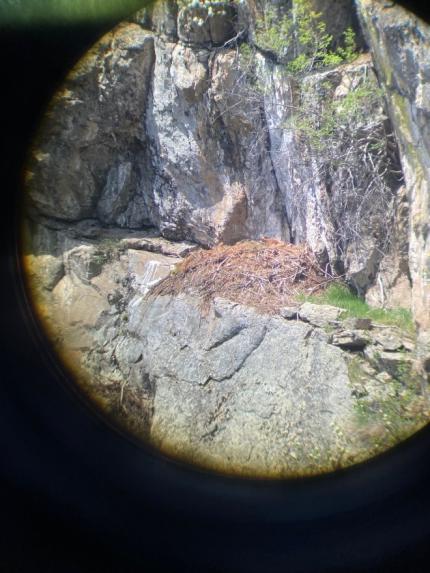
Wildlife Program report: May 1-15, 2023
Managing Wildlife Populations
Environmental Planner English is preparing a final draft of the L. T. Murray Wildlife Area management plan for State Environmental Policy Act review and public comment, following external review by the Yakama Nation, the L. T. Murray Wildlife Area Advisory Committee, United States Fish and Wildlife Service, and the Diversity Advisory Committee. A public open house on the plan is scheduled for June 21, from 6:00 p.m. to 8:00 p.m., at the Kittitas County Fairgrounds.
English initiated scoping for the Cowlitz Wildlife Area in May, which included an initial Wildlife Area Advisory Council meeting on May 9 followed by an internal scoping meeting with the internal planning team on May 16. A public open house is tentatively scheduled in Morton this July.
The Methow Wildlife Area planning team meeting was held in Winthrop on May 9. The discussion included recreation planning and suitability mapping, proposed winter closures, and restrictions on non-motorized seasonal recreation.
Methow Wildlife Area Advisory Committee meeting was held in Winthrop on May 11. Wildlife area staff members provided a wildlife area update. The meeting was focused on reaching a consensus on the seasonal closures to protect wintering mule deer. The next step includes developing an outreach approach for gaining public support for the winter closures.
The highlights of the year-long recreation user survey results were provided.
The first draft of the Skagit Wildlife Area management plan was reviewed by the planning team members. We are pleased to report the draft plan received comments from 15 planning team members, essentially most program participants contributed. The next steps include revising and preparing the next version for tribal and advisory committee review in June. A response to the comments received on the draft goals and objectives from the advisory committee is being prepared.
The Lands Division has collaborated with the Fish Program to develop an initial draft regional water access management planning framework. Modelled largely on the established wildlife area framework, it will facilitate the development of 10-year regional plans for the Department’s water access lands, including roughly 475 designated water access areas. Current plans are to first apply the framework as a pilot in the North Puget Sound Region.
Providing Recreation Opportunities
Environmental Planner Browning and Program Specialist Andersen hired TREAD, a trails advocacy organization, to do a trails assessment process in Quincy Lakes Wildlife Area. Once the assessment is completed, we will be one step closer to being able to designate trails there and manage the high level of recreation to better protect wildlife.
Providing Education and Outreach
The Ambassador Pilot Program will be launching on July 1. Browning is working closely with the contractor, Washington Trollers Association, to publish news releases, hire seasonal employees to manage volunteers, and begin volunteer recruitment.
The WDFW Sign Standards and Guidelines have been finalized and were emailed out to staff on May 15. The guidelines will be uploaded to the Land Manager Toolkit shortly.
Hardware for 19 kiosks in Region 4 have been ordered. Browning is working closely with Community and Public Engagement (CAPE) and the GIS team to finalize the artwork, maps, and design of the kiosks.
Managing Wildlife Populations
Golden Eagle Survey: Wildlife Biologists Prince and Turnock checked on two historic golden eagle territories and one potential new territory. A single historic territory had an adult eagle sitting on a nest and likely incubating eggs or newly hatched chicks.

Bats: Biologists Lowe and Brinkman captured bats to collect samples to test for presence of the fungus responsible for white-nosed syndrome, a disease linked to large bat die-offs throughout the United States. The capture was conducted at a maternity colony of Yuma myotis (Myotis yumanensis) in Whitman County with assistance from WDFW Private Lands Technician Nizer, two biologists with Bureau of Land Management (BLM), and a professor from Eastern Washington University with three of his students.
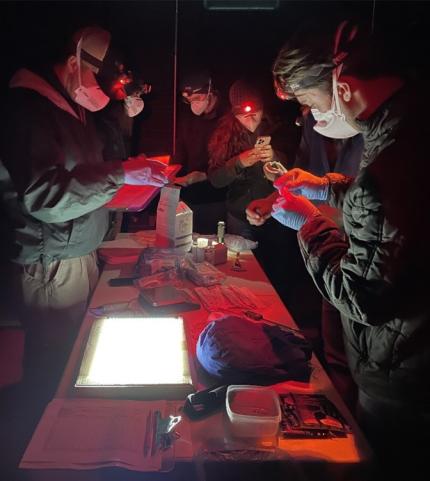
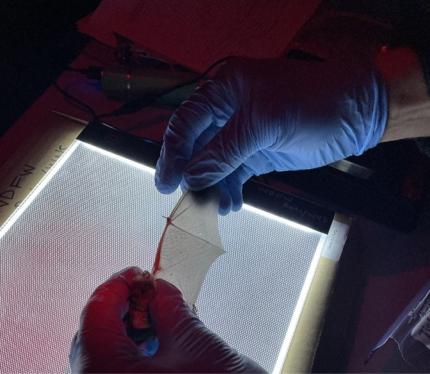
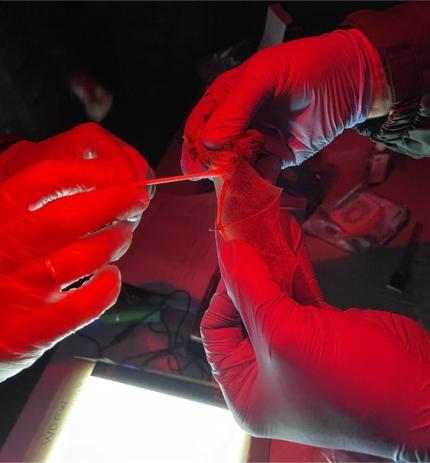
W.T. Wooten Wildlife Area Elk Fence: Wooten Wildlife Area personnel checked the elk fence from Mountain Road to the Wooten Headquarters. Wildlife Area Manager Dingman found a large hole in the fence that required Natural Resource Worker Jensen and Natural Resource Technician Tritt to return the following day with supplies to repair it.
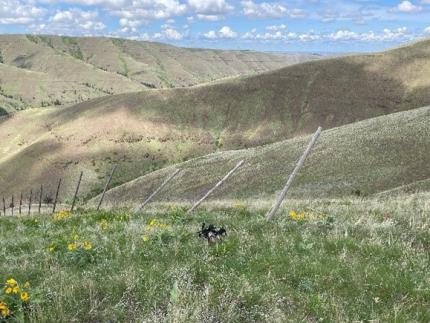
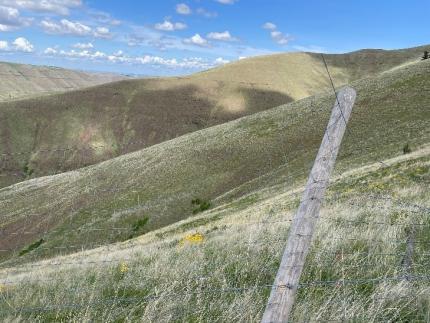
Providing Recreation Opportunities
Terminally Ill Hunter: Wildlife Conflict Specialist Kolb worked with an out-of-state hunter granted a terminally ill elk permit for later this summer. Kolb will try to ensure the hunter has property to hunt due to the game management unit (GMU) permitted being almost entirely private property.
Landowner Contact: Natural Resource Technician Janowski spoke with a landowner enrolled in Hunting Only by Written Permission regarding the spring turkey season and parking. The landowner received concerns from their neighbors regarding so many vehicles parked on the property and wanted a way to know if somebody is a hunter or not. Janowski informed the landowner to give hunters an extra blue slip with a cut notch to slide in the window visor to indicate to neighbors of who is a hunter or not. The landowner liked this idea and will implement this going forward.
Turkey Hunters: Private Lands Supervisor Earl discussed hunting opportunities with several people this week. One individual was out here from back East. He is trying to be the youngest person to complete the U. S. Super Slam. Earl was able to get him on some birds and he harvested a nice tom. His 44th state harvest. The following day he traveled into Oregon and harvested an Oregon tom which was #45 for his super slam. Earl also received a call from a successful hunter that harvested her first ever tom on a newly planted food plot that Earl seeded last year.
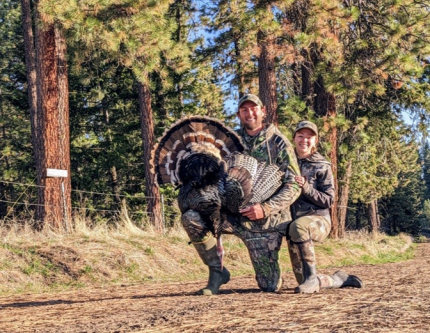

Mississippi Turkey Hunter: Wildlife Conflict Specialist Wade assisted a hunter who traveled from Mississippi to Washington to hunt turkeys. Wade as well as other WDFW staff assisted the hunter with finding locations to hunt. Wade followed up with the hunter who reported that he was able to fill both of his Washington turkey tags. The hunter was very thankful for the assistance from Wade and other WDFW staff members.
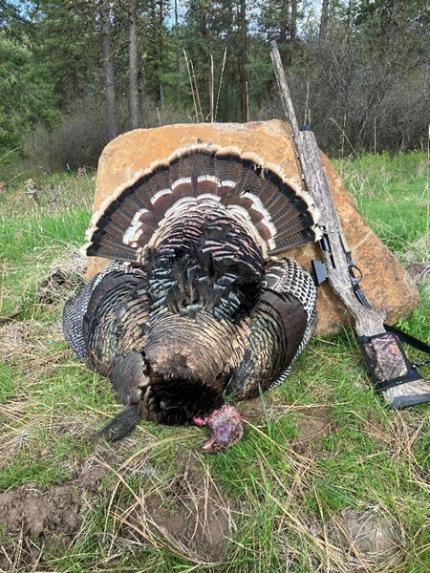
Providing Conflict Prevention and Education
Pend Oreille County Library Grizzly Bear Aware Events: Wildlife Biologist Turnock presented at a bear aware event hosted by the Pend Oreille County libraries that was coordinated by the Kalispel Tribe. The event taught participants about bear biology, how to tell the difference between grizzly and black bears, how to avoid negative interactions with bears, and how to use bear spray. There was a hands-on bear spray training taught by a U. S. Fish and Wildlife Service grizzly bear specialist and every participant went home with a free can of real bear spray at the end of the day. The events totaled over 50 participants and was put on in collaboration with the Kalispel Tribe, Defenders of Wildlife, WDFW, and the U. S. Fish and Wildlife Service.
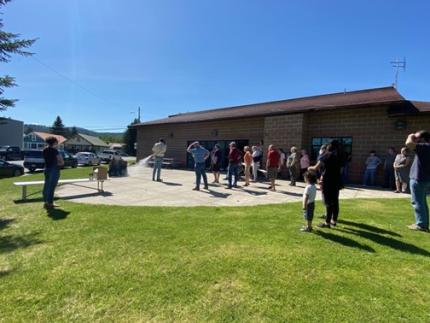
Asotin County Wolf Activity: Wildlife Conflict Specialist Wade continued to have check-ins with the Asotin County Cattleman’s Association president and multiple producers in the area of recent wolf activity. Wade traveled to the Anatone area to look at a cow that had died after falling off a bluff. Wade and the producer determined that the carcass could not be removed from the site. Wade provided the producer with lime to put on the carcass, which should discourage scavenging. While in the area, Wade checked the area of continued wolf activity near Anatone. Wade also worked with a producer to get access to their property so Wolf Biologist Spence could survey an area of dense wolf activity.
Bear Damage: Natural Resource Technician Harris followed up on a report of a black bear repeatedly getting into garbage. Harris received a phone call from a landowner in Stevens County that had a black bear get into her porch freezer. Harris deployed a game camera and electric fence around the porch.
Conserving Natural Landscapes
20th Annual Rocky Mountain Elk Foundation Work Party: Volunteers from the Rocky Mountain Elk Foundation gathered at Smoothing Iron Ridge on the Asotin Creek Wildlife Area for the 20th annual work party this weekend. There were 35 volunteers working on Friday, Saturday, and Sunday. Many traveled from Western Washington to participate. Even though the weather was wet, and mud prevailed, they were able tear out quite a bit of barbed wire fence destroyed during the 2021 Lick Creek Fire. They also removed hog wire from two burned enclosures used during pilot grazing 15 years ago. Additionally, several water troughs and springs were cleaned, one water trough was replaced, and salt blocks were placed at various locations for elk and deer. Assistant Wildlife Area Manager Woodall coordinated work activities this year. Also attending from WDFW was Wildlife Area Manager Dice and Natural Resource Technician Rimmelspacher.
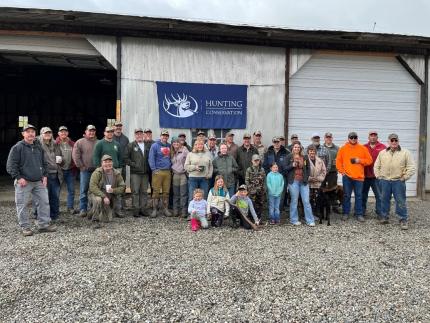
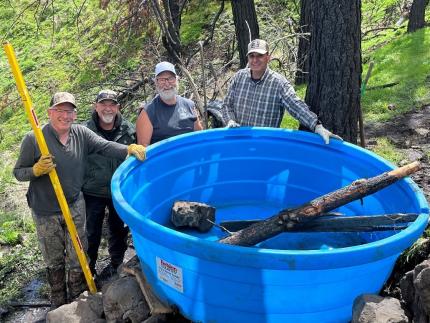
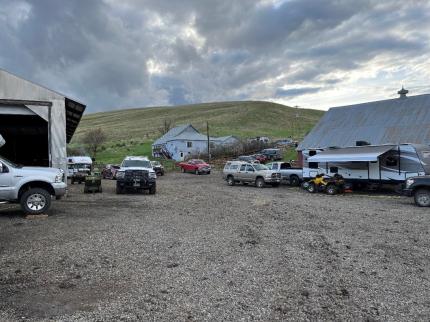
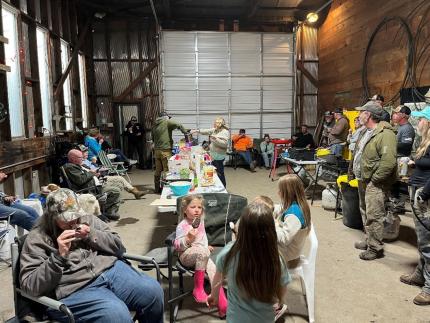
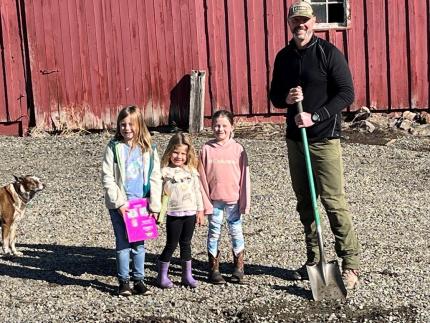
Tree Planting: Natural Resource Technician Janowski picked up 1,500 conifer trees for a planting project on a Hunting Only by Written Permission property. Janowski, Harris, Conflict Specialist Samsill, Inland Northwest Wildlife Council, and the Stevens County Conservation District all were able to plant 1,100 trees this week. Janowski will plant the remaining 400 trees early next week.
Wildlife Food Plots: Private Lands Biologist Gaston, Natural Resources Technician Nizer, and Natural Resources Technician Rumiser all finished installing wildlife food plots on private lands enrolled in the WDFW public access programs. Food plots were varied with some including alfalfa and clover, while others were more of an annual food plot mix.
Turkey Habitat Project: Private Lands Biologist Gaston and Natural Resources Technician Nizer worked with volunteers to finish planting trees on a project funded for turkey habitat restoration. The area is on private property enrolled in the WDFW Private Lands Access Program in the area recovering from the 2020 Babb-Malden fire.
Invasive Grass Species Test Plots: This week private contractor and former Bureau of Land Management employee Lorna Emerich and her husband Jim Emerich came out to start the pre-herbicide application data collection for the three invasive grass test plots that are already in place and measured out. Lorna is collecting the plant identification of species in each of the plots where five different herbicides will be tested. Lorna will be back in mid-July to repeat the data collection post application. Wildlife Area Manager Finch took photos on the ground and by using the drone for documentation.
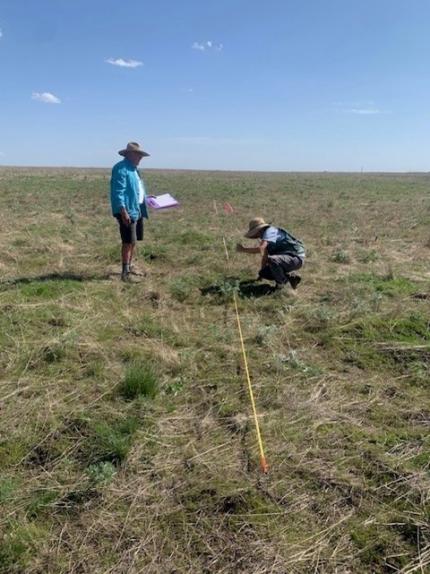
Hartsock Garbage Dump: Natural Resource Technician Tritt and Natural Resource Worker Jensen cleaned up approximately 40 tires that had been dumped in the ditch along Hartsock Grade. Access Tech Heimgartner hauled the tires to the Asotin County landfill for disposal.
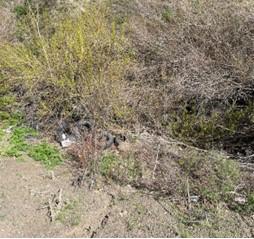
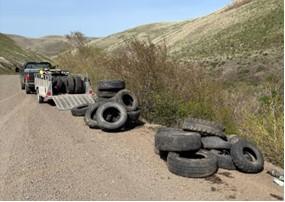
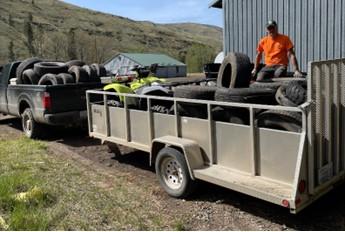
4-O Ranch Grass Seeding Project: Wildlife area staff members moved our seed drill from Smoothing Iron to the Bucannon Field on the 4-O Ranch Wildlife Area on Wednesday. Wildlife Area Manager Dice moved a John Deere tractor from Joseph Creek to the 4-O to pull the drill. Dice began seeding on Friday and ran out of seed late Saturday afternoon with about six acres left to go in the 53-acre field. We are planting the field to orchard grass as a lure crop to hold elk on the wildlife area.
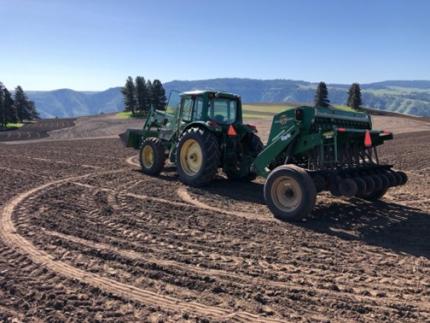
Smoothing Iron Ridge Spraying: Natural Resources Technician Meisner moved our 50-foot sprayer from the 4-O Ranch to Smoothing Iron Ridge on Wednesday. On Thursday, wildlife area staff set up the sprayer behind our Case 4490 tractor and began spraying glyphosate herbicide on fallow fields. We also set up a 30-foot boom sprayer on our 6130R tractor to begin spraying winter wheat fields for broadleaf weeds. There’s a lot more spraying to complete next week.
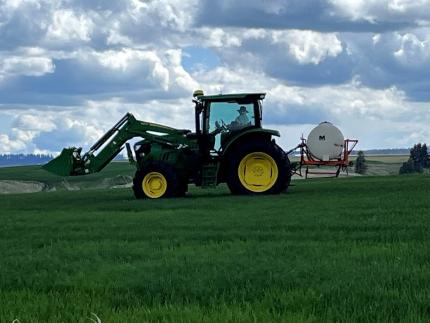
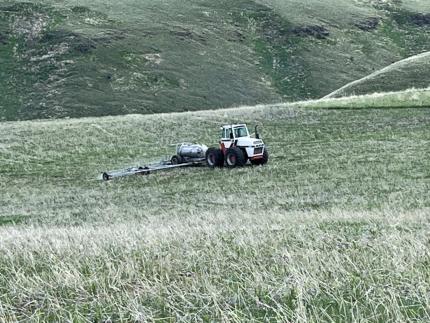
Conservation Reserve Enhancement Program Rehabilitation: Private Lands Biologist Gaston, Natural Resources Technician Nizer, and Natural Resources Technician Rumiser worked as a team to rototill, harrow, mow, and seed a small Conservation Reserve Enhancement Program project outside of St. John to assist the Rock Lake Conservation District. Rock Lake Conservation District Manager Harrold assisted with seeding and tree planting at the site and the project was completed in two days.
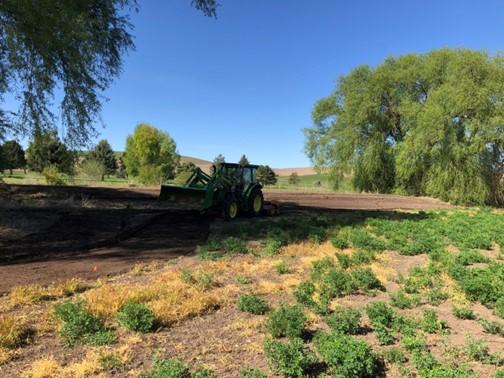
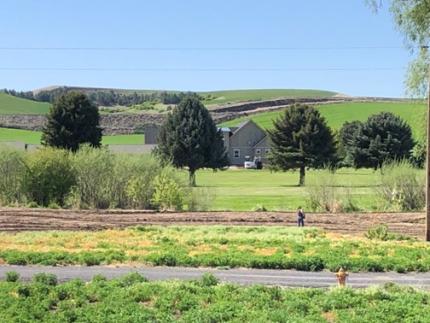
Invasive Grass Species Test Plots: This week Wildlife Area Manager Finch and Spokane District Wildlife Biologist Lowe spent a day mixing up five different post emergence herbicides to apply to the three different test plots. Botanist Emerich completed her line intersect data collection last week identifying all the species in each of the plots preapplication. Emerich will come back again in July to do a post-application line intersect data collection.
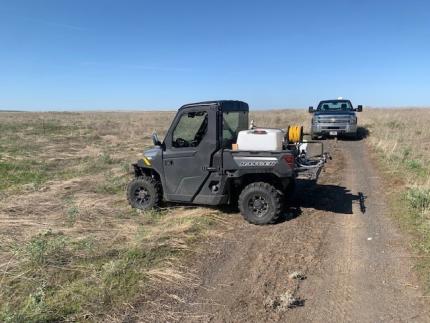
Hartsock Unit Floodplain: Wildlife Area Manager Dingman took her all-terrain vehicle out the ridge between Hartsock Grade and the Tucannon to take photos of the changes that are occurring in the Hartsock Unit floodplain. The Quonset and bunkhouse were removed in 2012, the Confederated Tribes of the Umatilla Indian Reservation completed a large wood restoration project in 2017, and the Tucannon River is slowly reclaiming the floodplain.
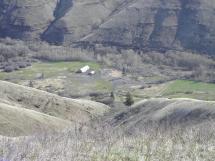
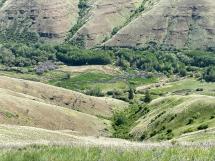
Providing Education and Outreach
Cattlemen’s Meeting: Wildlife Conflict Specialist Kolb and Wolf Biologist Spence attended the Columbia County Cattlemen’s Association meeting and provided an update on wolves. Wolf Biologist Spence gave a presentation on the Annual Wolf Report and Kolb talked about cost-share programs available to producers to off-set the cost of implementing non-lethal deterrents.
Lakeside High School Field Day: Natural Resources Technician Nizer, Private Lands Biologist Gaston, and Natural Resources Technician Rumiser attended the field day for Lakeside High School hosted at the Spokane Hatchery. Nizer and Rumiser setup and demonstrated the Truax no-till drill and had the students assist with learning how to calibrate the machine. Gaston and Nizer setup a line transect for field identification of plant species the students had to walk and identify.
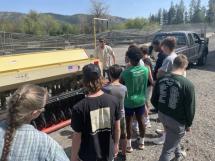
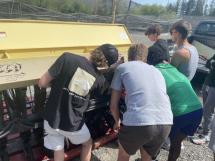
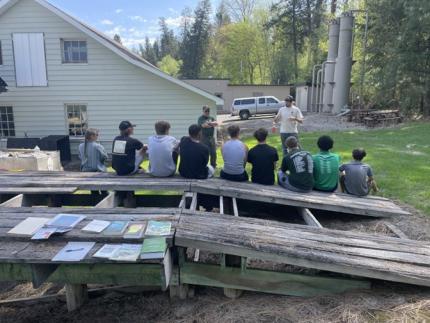
Lecture and Lab: Wildlife Conflict Specialist Kolb, Assistant District Biologist Vekasy and Scientific Technician Moberg conducted a chronic wasting disease lecture and lab with students at Touchet High School.
Conducting Business Operations and Policy
General Facilities and Equipment Maintenance and Repairs: Sherman Creek Wildlife Area Assistant Manager Palmer, Natural Resources Technician Zueger, and Wildlife Area Manager Anderson inspected the irrigation diversion box, settling box, and fish screen at Sherman Creek. Palmer and Zueger had worked earlier in in the week to remove silt and debris from the side channel diversion. As high as the creek was running, it was running even higher the previous week, with the sound of boulders bumping downstream clearly audible. The creek is expected to rise again in the upcoming week as heat keeps melting mountain snow.
Managing Wildlife Populations
Washington Ground Squirrels: District 7 biologists and Scientific Technician Hara have started surveying for ground squirrels in Douglas County. Washington ground squirrels are designated as a Species of Greatest Conservation Need by Washington Department of Fish and Wildlife (WDFW). In the spring/summer of 2023, biologists are surveying historic and recently occupied sites to determine if ground squirrels are currently using these sites. Documentation of active ground squirrel locations can help with this species’ recovery by identifying priority areas of suitable habitat to conserve.
Technician McCallum has been knocking out historic ground squirrel sites within Grant and Adams counties. We are nearly approaching, if not already there, 50% of our sites being surveyed! Washington ground squirrels have been detected in several of these historic sites. Ground squirrel pups are out and about now which should make auditory detections pretty easy.
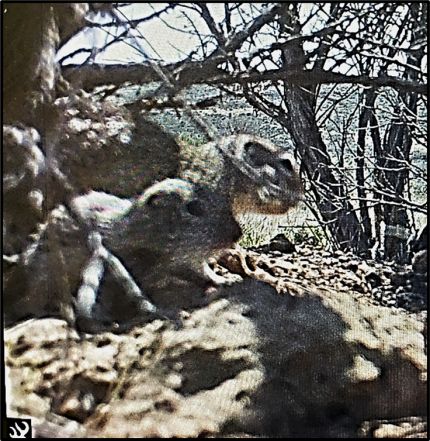
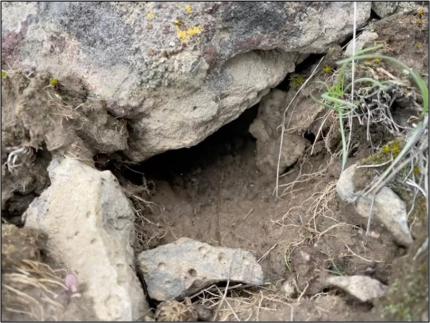

Furbearers: The deadline for hunters and trappers to have this season’s bobcat and river otter pelts sealed was April 20, 2023. Biologist Eilers sealed quite a few bobcat pelts that came in right before this cut-off date. Successful hunters and trappers of bobcat and river otter must contact a WDFW office for pelt sealing each year and submit the associated harvest report to the Department by the deadline. The sealing process involves placement of a numbered plastic band through a small hole cut into the pelt. This seal identifies the pelt’s origin and indicates that it has been legally harvested. This is to prevent overexploitation of these species, as a taxidermist cannot accept a pelt that does not have a seal. Biologists also record age and sex of sealed animals and use these data to monitor harvest trends.
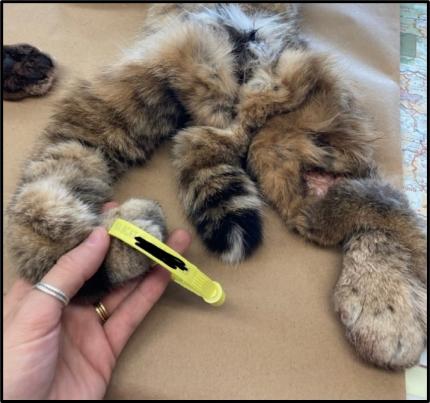
Northern Leopard Frogs: Biologists Dougherty and Clements with a ton of help from Technicians Bancroft and Kleinhenz have been busy daily conducting egg mass surveys and call surveys for northern leopard frogs. So far, they have detected a total of four northern leopard frog egg masses in the potholes area! Biologist Dougherty even caught a pair of frogs in the act of breeding. Technician Bancroft made the trip with precious cargo and took 200 eggs to the Oregon Zoo in Portland.
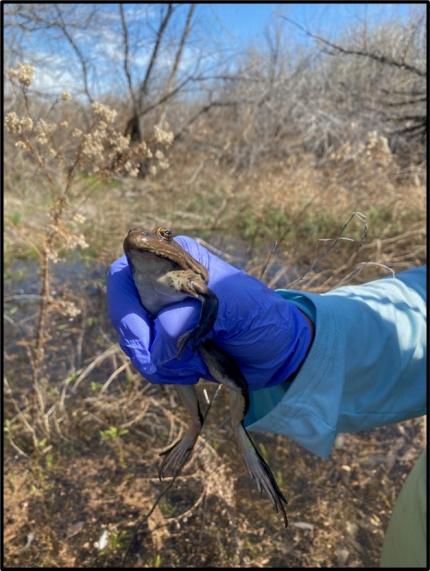

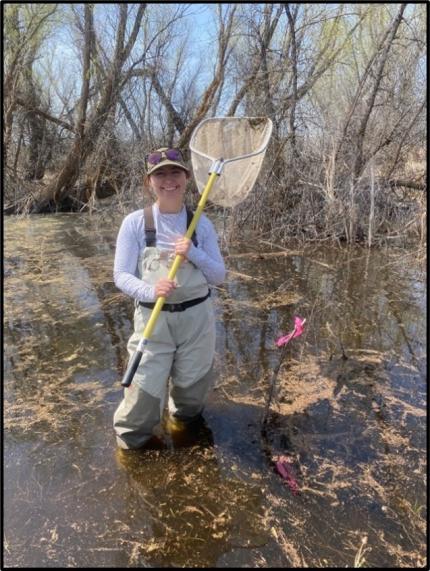
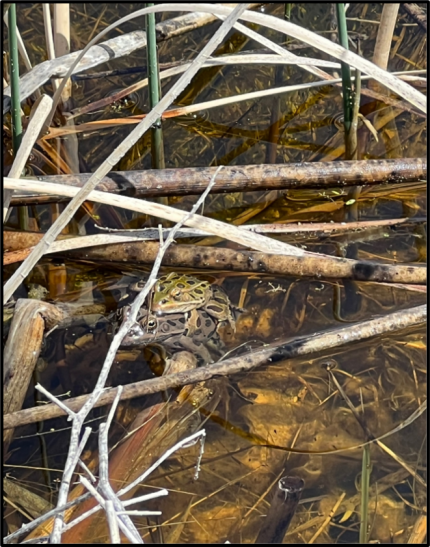
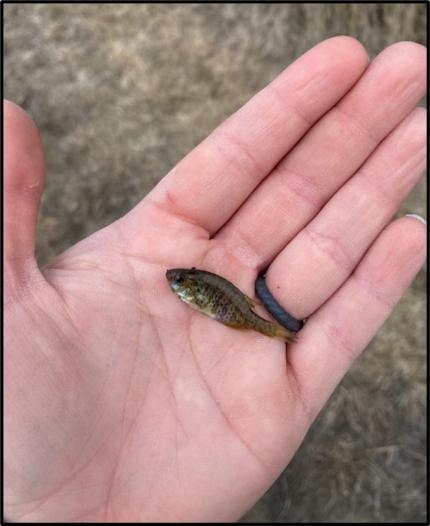
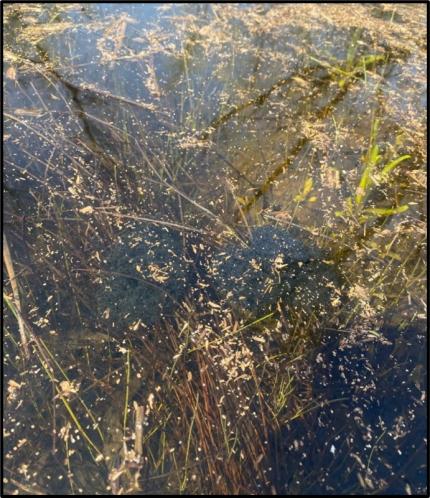
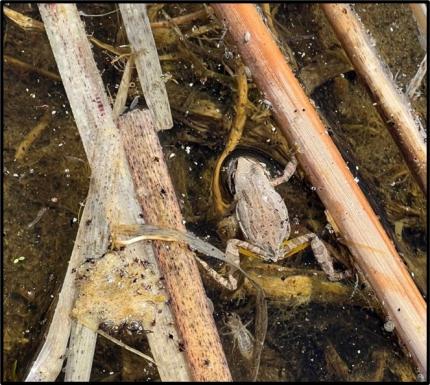
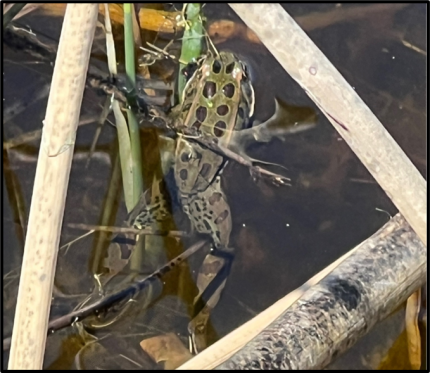
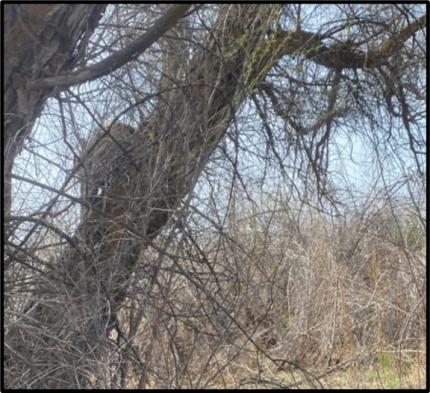
Signs of Spring: The sagebrush steppe is rapidly turning into spring mode. First with the arrival of sagebrush buttercups and now a whole slew of wildflowers are popping up including yellowbells, bluebells, violets, balsamroot, spiny phlox and more! The team was out scouting for pygmy rabbit burrows when Biologist Gallie spotted a spring pool. Inside, there was a Pacific tree frog and several egg masses. This “green-up” of the landscape is very promising for pygmy rabbits because having sufficient forage is essential for the health of pregnant females and new-born kits.
Greater Sage-Grouse: Biologists Jeffreys and Eilers and Technician Hara have started the 2023 season of sage-grouse lek counts in Douglas County. A lek is a gathering of birds in a clearing of vegetation, where the males perform a dancing display to impress potential mates. As part of their display, the males gulp and hold air in a pouch of their esophagus, and squeeze the air out with force to make a unique sound. Often only the best one or two males get picked by the majority of the females for mating. These leks gather before sunrise in the spring months and are sensitive to disturbance. Biologists surveying these leks keep a far distance and count the number of birds using a spotting scope.
Greater sage-grouse are State Endangered and are a Species of Greatest Conservation Need. The Washington population of these iconic shrubsteppe birds is very low and the vast majority are found in Douglas County. Over 95% of greater sage-grouse habitat has been lost in Washington, and what little shrubsteppe remains has been impacted, and will continue to be impacted, by invasive plant species, wildfire, fragementation, and development.
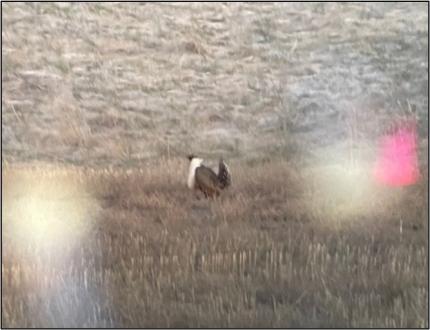
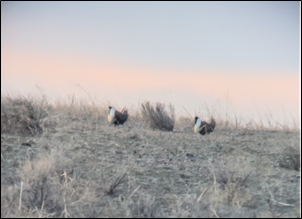
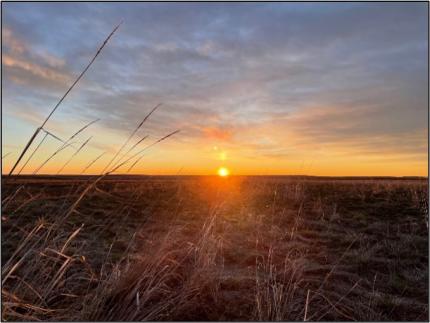
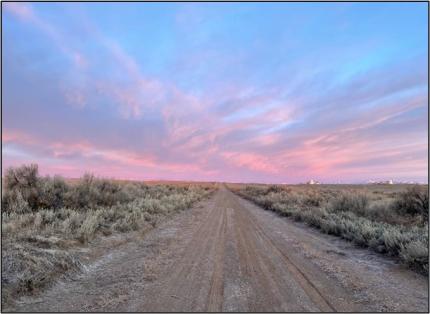
Columbian Sharp-tailed Grouse: Biologists Jeffreys and Eilers joined other biologists in trapping and relocating 40 sharp-tailed grouse from British Columbia, Canada into Washington to help supplement this species’ abundance and genetic diversity in Washington. Sharp-tailed grouse are State Endangered and are a Species of Greatest Conservation Need due to their low and declining numbers in Washington. The translocation effort involved finding leks in B.C., setting up walk-in traps, and then returning each morning to watch from a blind as the birds performed their daily displays. Once a bird found itself in a trap, biologists quickly left the blind and captured the bird to bring it to a processing site. All 40 grouse (20 male, 20 female) were banded and outfitted with a radio collar or GPS transmitter to allow biologists to track their movements before being driven across the border. For more information about this species, visit: Columbian sharp-tailed grouse | WDFW.
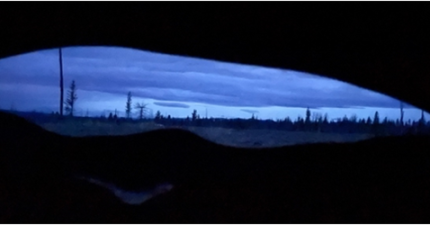
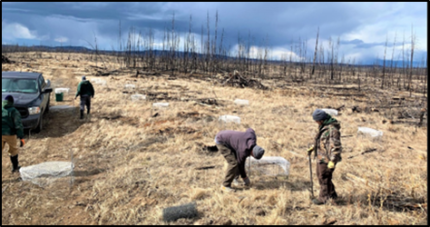
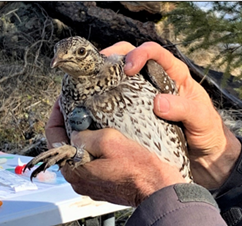
Sharp-tailed Grouse Translocation: A dedicated and sleep-deprived team of WDFW, tribal, and Canadian biologists successfully translocated 40 sharp-tailed grouse from near 70-Mile House, BC to new homes in the Okanogan Valley. Twenty birds (10 males and 10 females) were released on an active lek on the Scotch Creek Wildlife Area, and an identical number were turned out on a lek in the Tunk Valley. Translocated birds are now being actively monitored and six are sporting new GPS collars that are greatly enhancing our ability to follow their movements. As expected, some birds have already made wide-ranging exploratory forays. However, many have remained in the general vicinity of where they were released. As with past translocations, this effort is expected to improve the genetic fitness of the Okanogan population in addition to locally enhancing sharp-tail numbers. Many thanks to all the participants!
Grouse Surveys: Private Lands Biologist Braaten continues to survey grouse this week in Douglas County. Sage and sharp-tailed grouse are attending most leks.
Scotch Creek Sharp-tailed Grouse Translocation and Lek Surveys: Scotch Creek Wildlife Area Manager Dupont released several translocated sharp-tailed grouse from southcentral British Columbia to the Scotch Creek Wildlife Area. Dupont and Professor Gala from Boise State University led multiple releases onto WDFW property.
Staff members also continued lek surveys on the Scotch Creek Unit and Chesaw Unit. Five leks have been surveyed. Attendance continues to be lower than in previous years.
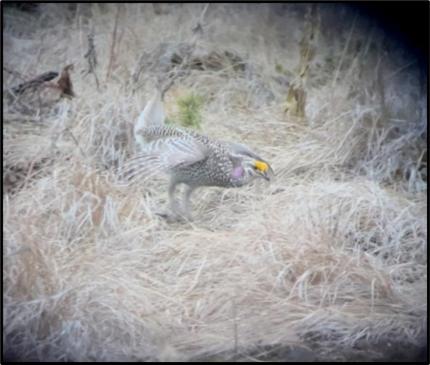
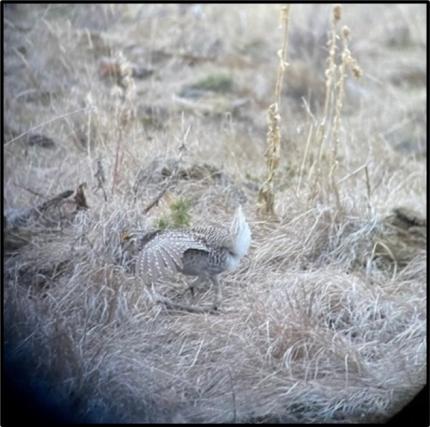
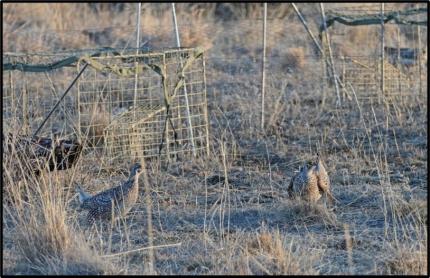
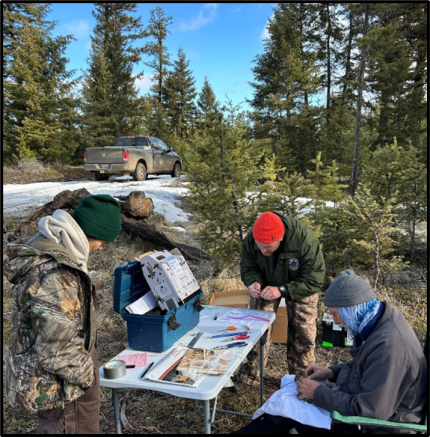
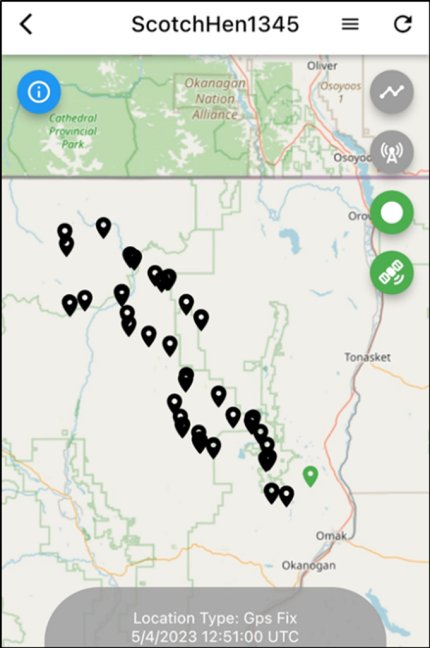
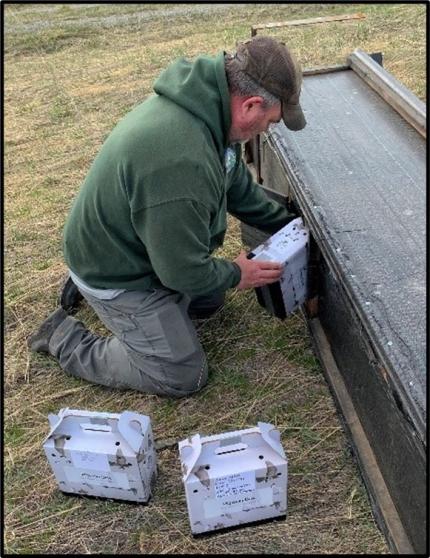
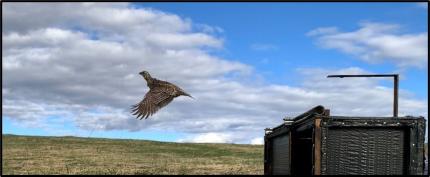
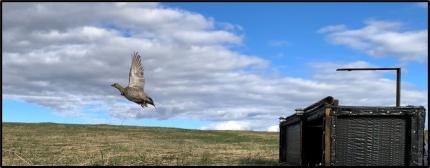
White-headed Woodpeckers: Biologists Eilers and Jeffreys along with Chelan Public Utilities District biologists kicked off a third year of cavity-nester studies in Rocky Reach Wildlife Area. The focus of the initial study year in 2021 was to determine occupancy of Lewis’s woodpeckers and white-headed woodpeckers. Both are designated Species of Greatest Conservation Need by WDFW. Last year, biologists sought to find nest cavities for both species and carry out habitat analyses to learn more about how these woodpeckers choose their nest sites, but only Lewis’s woodpecker nests were found. This year, the goal is to find breeding pairs of white-headed woodpeckers, locate their nests, and analyze nest-site characteristics. To that end, biologists are revisiting previously surveyed grids in which white-headed woodpeckers were detected in 2021 and/or 2022 as well as surveying several new grids. White-headed woodpeckers are territorial and announce their territories using drumming and rattling calls, to find any birds that might be present biologists use a speaker to broadcast white-headed woodpecker calls. Biologists then attempt to follow any birds that fly in to investigate, to search for a potential nest cavity.
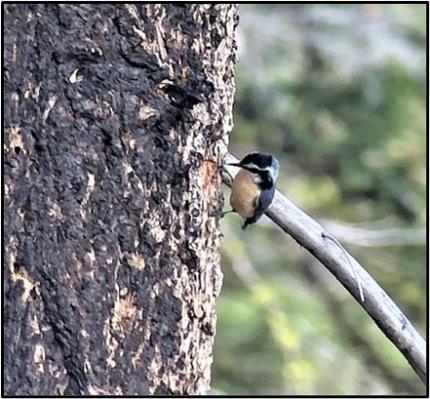
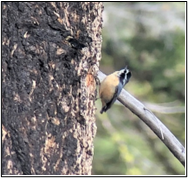
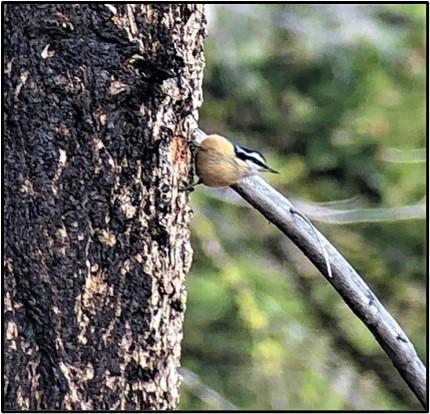
Monitoring Waterfowl Abundance with Camera Traps: Specialist Walker and Worker Clifford deployed eight trail cameras at the Frenchman Regulated Access Area and TD-2 project to continue a waterfowl abundance study. Cameras are attached atop a 20-foot steel pipe which typically requires two people to lift and set in place. Cameras will take one photo per hour during daylight hours until early May to monitor waterfowl use of these project areas.
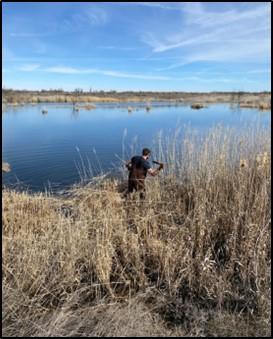
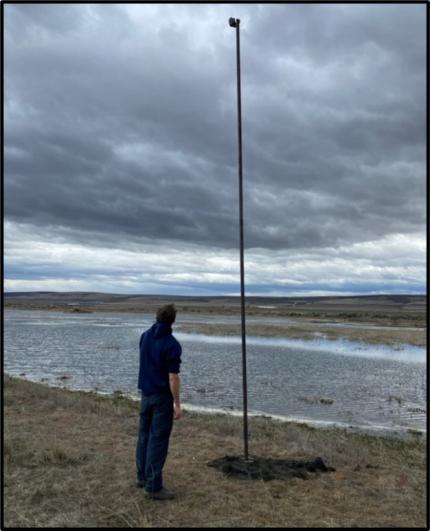
Experimental Drone Surveys: Data Manager Jansen paved a new direction for the pygmy rabbit team when he came and flew drones over the Palisades area. The drones were taking imagery that will later be used to pick prime release areas. Preliminary data has everyone excited. The team was able to identify burrows from the aerial imagery and then do some ground-truthing. The data also provided WDFW with 3D maps of the area. This will allow us to zoom in on the sagebrush to see which stands are the thickest. The next step will be to fly the drones in areas with pre-existing vegetation data and rabbit burrows.
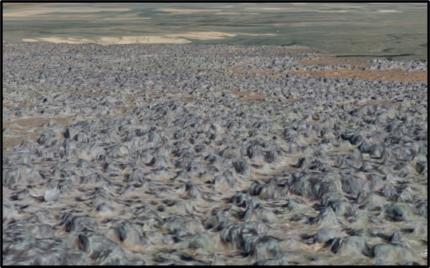
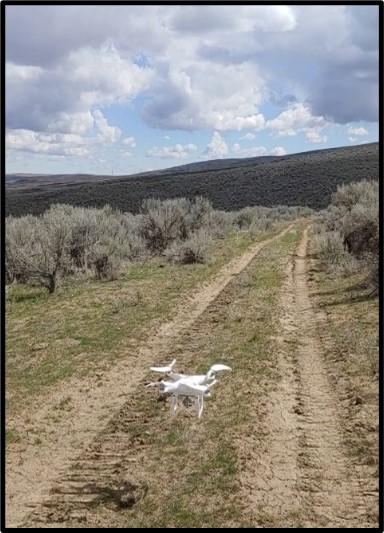

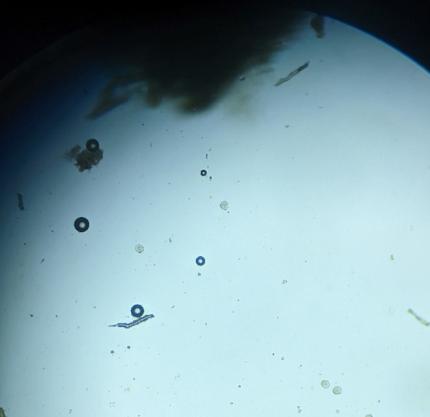
Rabbit Necropsies: Whenever the team recovers a pygmy rabbit carcass, a DNA sample is taken, and the body is preserved in the freezer until necropsies can be performed. Often, carcasses are in such poor condition that not much information can be obtained. In some cases, a liver sample can be removed and sent to the Washington Animal Disease Diagnostic Laboratory. While it is a very stinky endeavor, it is important for the pygmy rabbit team to investigate every mortality event.
Coccidia Testing: Coccidia is a parasite that resides in the intestines of a rabbit. At certain times of the year, adults will shed this parasite in its poop. This can be particularly dangerous for young kits when it is observed in high levels. Every month during the breeding season, the pygmy rabbit team collects fecal samples from breeding enclosures and inspects them under the microscope. In our most recent sampling, enclosure B3 has tested positive for increased coccidia levels. Luckily, there is a medication called Amprolium that we will administer to treat coccidia.
Kit Searching: Game cameras have been deployed in all the breeding enclosures and on several wild burrows in Beezley Hills and Rimrock Meadows. The burrows were carefully selected by looking at our genetic data results. We chose burrows that showed the presence of females in hopes that we can capture the emergence of kits. Once kits are shown moving on the landscape, the pygmy rabbit team plans on capturing approximately five wild pygmy rabbits and placing them within our breeding enclosures to increase genetic diversity and to increase breeding output for releases.
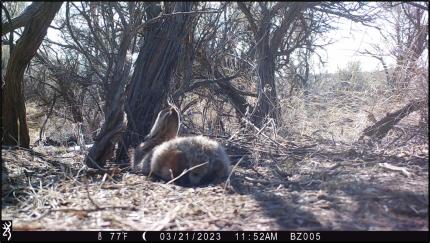
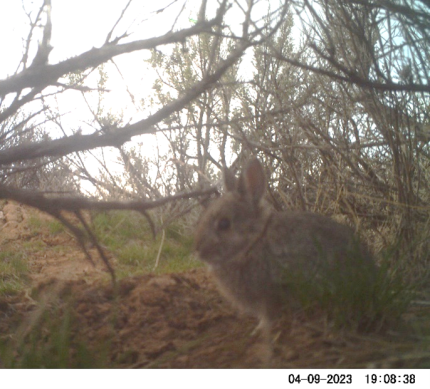
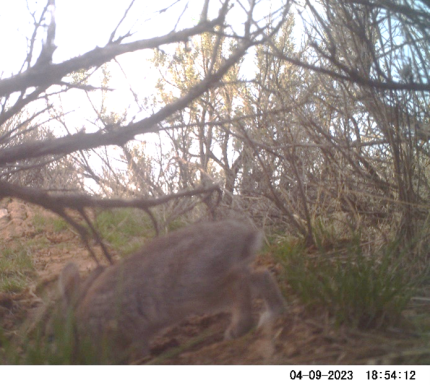
District 6 Mule Deer Monitoring: Biologists Fitkin and Heinlen wrapped up spring mule deer surveys having classified 1565 animals in the western 2/3 of District 6. The resulting fawn to adult ratio of 20:100 is the lowest observed since the spring of 2007. That is significantly below the 10-year average of 32:100. This indicates higher than average over-winter fawn mortality, which was not too surprising since this past winter was arguably the toughest in the district since the harsh winter of 1996-1997.
Landowner Coordination for Surveys: Biologist Morris and Biologist Cook helped the pygmy rabbit crew and an assistant district wildlife biologist gain access to private property for pygmy rabbit and Washington ground squirrel surveys. More than six private landowners were very willing to cooperate with the department to allow for these surveys to move forward on private ground.
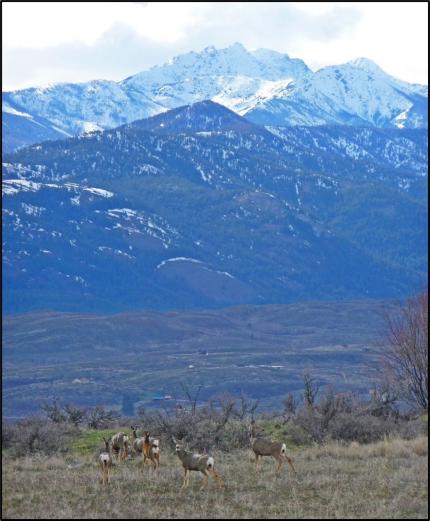
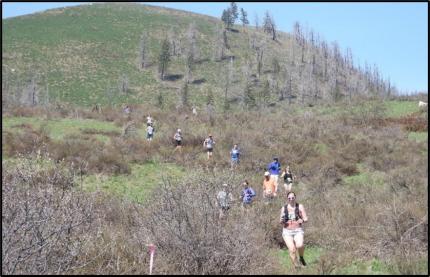
Providing Recreation Opportunities
Hunter Access Program: Biologist Morris worked on updating contracts for Hunting Access so they will be ready for this fall. He also worked on a fishing access contract that the Private Lands Program is taking over from the Lands/Access Program.
Providing Conflict Prevention and Education
Wildlife Area Gates: Biologist McPherson received three new swing gates that were recently made by a local fabricator. The new gates look great and are very sturdy and the fabricator made some new improvements to help with overall function and longevity. The gates are now painted white, and they are ready for installation.
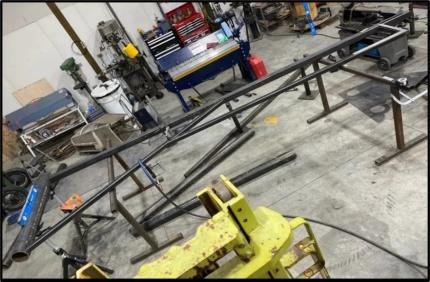
Russian Olive Removal: Wildlife area staff members have been working on burning piles of Russian olive around the Winchester Wasteway. Piles have been aging for two years to help consumption of materials. Focus has been primarily on the eastside due to conditions and the westside will need some preparation work before burning can commence.
Biologist McPherson, Specialist Walker, and Worker Clifford removed a large Russian olive off Sand Dunes Road. This tree usually is a frequent area of nefarious activity since it provides for some seclusion. By removing this tree, we should see a reduction in dumping and people who overstay the 14-day limit on camping.
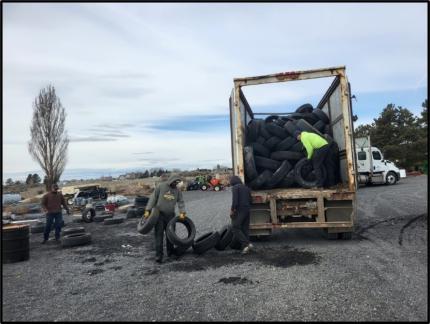
Department of Ecology Tire Pick Up: Biologist McPherson has been communicating with Department of Ecology tire pick up program for some time now. Due to contracts being inactive for some time, wildlife area staff and Washington Conservation Corps (WCC) crew members have been collecting tires for about two years. Our tire collection has reached about 600 tires. We now have an active contract with Liberty Tire Recycling out of Spokane. They came to our headquarters and finally took the tires off our hands.
Pre-Grazing Season Coordination: Specialist Heilhecker spoke to United States Forest Service (USFS) range staff members for the Methow Valley and Tonasket ranger districts. They discussed wolf locations, range rider availability, and turnout dates.
Deer Damage to Orchard: Heilhecker visited with an orchardist regarding winter deer damage. High snow depths compromised their fence and allowed the deer to jump into the orchard. She recommended the orchardist plow around the outside perimeter of the fence next winter to remove the snow and keep the fence eight feet high. Specialist Heilhecker gave the orchardist information explaining how to file for crop damage compensation.
Sharing of Information: Heilhecker notified two livestock producers of a wolf den location.
Skunk Call: Heilhecker received a call regarding a skunk using a crawlspace under a house. The landowner has tried many times to block the entrances used by the skunk, but the skunk keeps excavating around the barriers. Heilhecker suggested placing ammonia in the crawlspace if no pets or children are in the area. The landowner also set a livetrap to catch the skunk.
Range Rider and Livestock Turnout Coordination: Heilhecker spoke to USFS range staff and a WDFW contracted range rider regarding livestock turnout. The contracted range rider will start riding pastures next week to look for wolf activity before livestock go out on June 1.
Conserving Natural Landscapes
Garbage in District 5: Biologist Clements finished conducting ground squirrel surveys and noticed a spot that along the Lind Coulee that become a spot for dumping. She ended up going on an easter egg hunt and collected six bags of trash, a disintegrating box, and over 20 easter eggs.
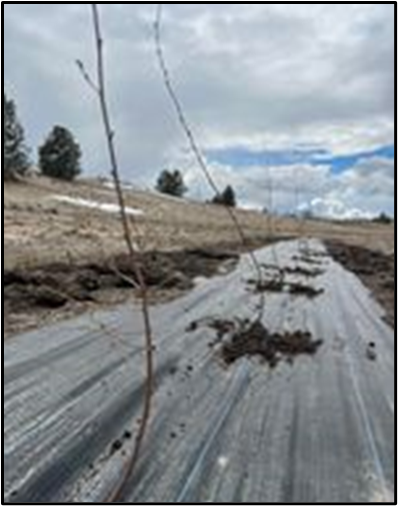
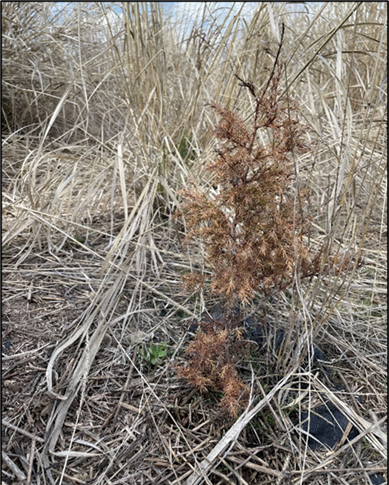
Habitat Project Planting: Private Lands biologists began planting water birch in north Douglas County. Biologist Morris checked on plantings from 2021 and 2022. In one area, junipers that were planted are in poor condition. Morris will be brainstorming ideas to improve their condition and survival.
Cooperative Burn: Sinlahekin Wildlife Area Manager Wehmeyer, Methow Wildlife Area Manager Troyer, and North Central Wildfire Prescribed Burn Member Kave participated in the second of three cooperative burns near the Highlands 20 Fire Camp on the Sinlahekin Wildlife Area. The 58-acre (35 acres on Department of Natural Resource (DNR) land and 23 acres on WDFW land) prescribed fire included mostly DNR staff members but both USFS and WDFW staff members assisted within the prescribed burn. WDFW Prescribed Burn Manager Eberlein provided significant assistance in the drafting of the burn plan and staff members also helped brief both groups of staff members prior to burning. One more burn unit remains in the cooperative burn area and could happen sometime this spring.
Lands 20/20 Lands Operations Manager: Lands Operations Manager Haug met with Region 2 and Lands Division staff members to discuss upcoming acquisitions and report on ongoing projects. The group discussed the new process and schedule for the upcoming year. They discussed what projects on their agenda need to remain, which required more work, and which should be removed from consideration.
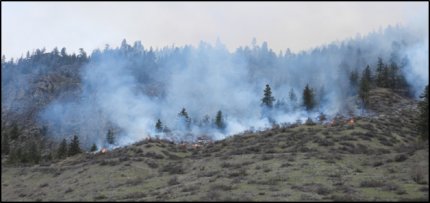
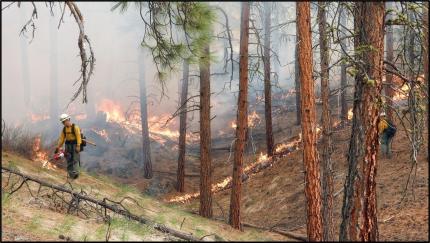
Sinlahekin Habitat Management: Assistant Manager Riley and Natural Resource Specialist White were able to remove approximately 9,000 feet of dilapidated pasture fence on the McLoughlin Unit. Most of the fence was covered with shrubs and grass. It was a combination of field fencing and barbwire fence. Most of it was attached to steel post or pipe with multiple wire ties or high tensile wire. The fencing was a barrier and it posed a threat for wildlife getting caught in it when they went through the area. Sinlahekin staff members also continued annual maintenance of the access site parking lots of various units when weather conditions were conducive to herbicide treatment. This treatment will help prevent noxious weeds from growing in the parking lots and help to minimize potential fire hazards.
Scotch Creek Riparian Restoration and Shrub Enclosure Maintenance: Staff members removed the fence around the exterior boundary of the project area, as the fence is becoming hard to maintain due to deterioration from age and it is no longer effective at keeping deer from browsing newly planted shrubs. Staff members also planted 100 aspen and 50 water birch trees in one of the existing high fence enclosures. Both species are important winter food sources for sharp-tailed grouse.
Staff members spent a large amount of time repairing shrub enclosure fences damaged by heavy winter snow. The heavy snow also damaged existing native riparian shrubs that were planted over the last ten years by breaking branches and smashing limbs down to the soil surface, allowing mice to girdle and strip the bark from the limbs.
Habitat Plots: Private Lands Biologist Cook and Private Lands Tech Blanchard, dumped three additional loads of wood chips on food plots to help improve soil structure and help with moisture retention. They also talked with a landowner about getting him signed up as a wildlife view area and his plans on planting this year.
Biologist Cook and Technician Blanchard visited a site seeded with native grasses in fall 2021. With a dry spring and summer in 2022, the grasses were not fully established in all areas of the field but were present. Some additional herbicide application this year may be needed to assist with full establishment.
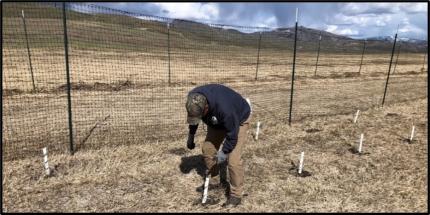
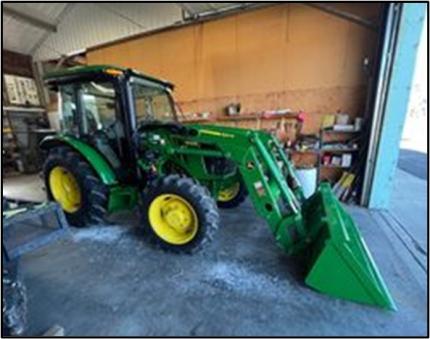
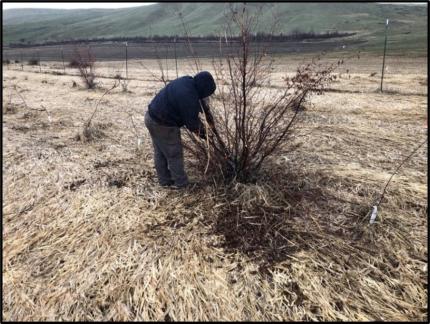
Methow Wildlife Area Noxious Weed Control: Assistant Manager Repp has been busy with herbicide applications throughout various locations of the Methow Wildlife Area. Spring showed up late this year, but it’s full steam ahead now. Recently, Repp has been concentrating efforts on commonly traveled roads and parking areas such as Pipestone Canyon, Golden Doe, Wolf Canyon, Bear Creek Campgrounds, Shooting Range, Lewis Butte, and Riser Lake to name a few. Weed control efforts will continue over the coming weeks in some of our shrubsteppe restoration fields as well as the Big Valley.
Methow Wildlife Area Volunteers: Volunteer projects have quickly ramped up with spring finally upon us. Several volunteers have been cleaning out and documenting nest boxes throughout the valley. There’s also been a few volunteers gradually picking away at unnecessary fences around the Big Valley trail system. Additionally, the local chapter of Backcountry Horsemen rebuilt a few sections of buck and rail fencing at the Beaver Creek Campground. Coming up this weekend, Backcountry Hunters and Anglers will be showing up with nearly 30 volunteers to assist Methow Wildlife Area staff in wrecking out barbed and woven wire fences at various locations throughout the wildlife area, followed by a BBQ and campout.
Frenchman Reserve Grazing Fence: During the process of Grant County Public Utility District contractors clearing Russian olives under power lines, the fence lines on reserve boundary were damaged. Since grazing season is quickly approaching, fences need to be repaired to keep cattle contained. To make sure fences were properly repaired, Biologist McPherson coordinated with the Washington Conservation Corps (WCC) crew to make repairs before grazing commenced for the season.
Chelan Butte Field Restoration: Technician Zabreznik was able to drill seed fields on the Chelan Butte that burned in the 2022 Stayman Flats Fire. There is still snow in some areas, and muddy conditions in other areas. The wildflowers are beginning to bloom, sagebrush buttercup, yellowbells and desert parsleys were all seen blooming.
North Wind Aviation was hired to seed the fire breaks by helicopter, and some fire breaks were seeded by hand.
Beebe Springs opened to the public after its seasonal winter closure and has seen regular use.
Providing Education and Outreach
Washington Conservation Corps Weed Workshop: Wildlife area staff members provided a space for a WCC noxious weed workshop at their headquarters. This workshop will allow for all Eastern Washington crew supervisors to gain credits toward their recertification period.

Oroville High School Field Day: Staff members joined Oroville High Schools Greenhouse Management Teacher Vanderwal, and four of her students. They planted cuttings and stakes on a riparian restoration project along Tonasket Creek on the Charles and Mary Eder Unit. The plants were propagated in the school’s greenhouse.
Turkey Season Information: Specialist Heilhecker received a call from an out-of-state hunter. The hunter was interested in suggestions for turkey hunting locations.
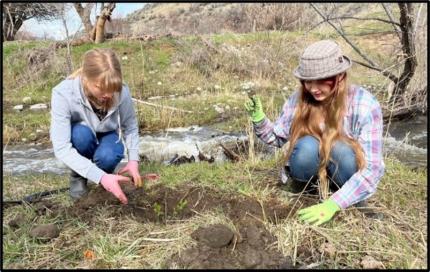
2023 North Central Washington Envirothon: WDFW staff members participated in the 2023 Envirothon in Waterville, WA. Private Lands Biologists Braaten, Cook, and Morris and Natural Resource Technician Blanchard manned the wildlife station and assisted in the administration of the wildlife quiz related to area wildlife and habitat to eight high school teams from three schools. Question topics included Aquatic Ecology, Forestry, Soils and Land Use, and Wildlife.
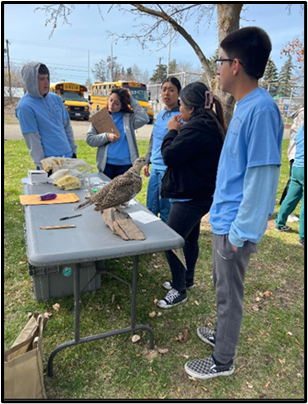
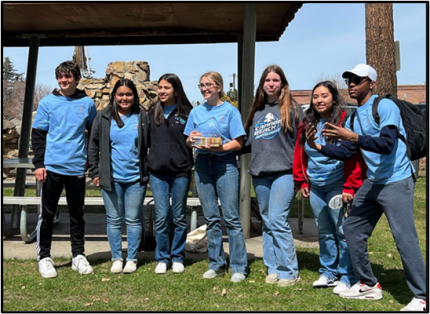
Liberty Bell Career Day: A few weeks ago, Methow Wildlife Area staff were invited to a career day event at Liberty Bell High School. Methow staff members decided to bring all three employees to give students a better idea of some of the different careers that might be available to them if they choose a career in public land management. Local staff members ran into Daley from the local USFS ranger district, and they decided to team up for the event. The Methow crew members brought skulls, hides, and informational materials and Daley brought candy. This combination was hit and the booth was well visited.

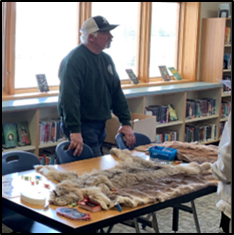
Science Technology Engineering Arts and Math in the Field: Lands Operations Manager Haug, Sinlahekin Wildlife Area Manager Wehmeyer, Assistant Manager Riley, Natural Resource Specialist White along with members of the Washington Department of Natural Resources (DNR) and the Methow Beaver Project worked with staff members from the North Central Educational Service District (NCESD), Tonasket Elementary, and Oroville Elementary to hold a Science Technology Engineering Arts and Math (STEAM) field trip to the Sinlahekin Wildlife Area. Over two days, Tonasket and Oroville elementary schools brought over 100 students to the wildlife area. The purpose of these visits was to take their classroom science learning into the field for an authentic science experience.
Students worked alongside agency staff members to collect forestry data, identify important plant species, learn about animal species in the area, and draw their observations above Forde Lake in an effort to learn more about forestry and fire ecology in Okanogan County. DNR Highlands District Manager Townsend, DNR Forester Smith, and DNR Biologist Breitenbach discussed forest management, forest species, instructed them on the use of forestry tools to measure DBH (Diameter at Breast Height), determined tree height, and talked about the importance of forest health. WDFW staff assisted with the planting of native species such as golden current, blue elderberry and serviceberry while discussing the importance of these shrubs to various wildlife and pollinator species. Nelson with the Methow Beaver Project discussed the importance of beavers in our local ecosystems. Thompson from Methow Arts and Haug from DNR instructed students to draw the landscape using charcoal near Forde Lake. Engagement from students was high and comments from teachers and parents were extremely positive.
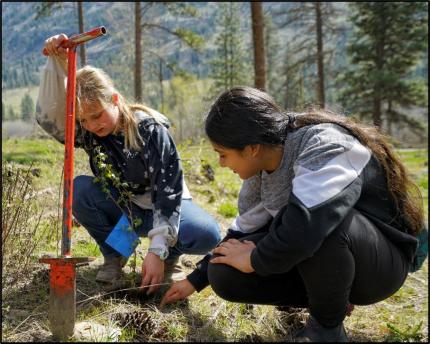
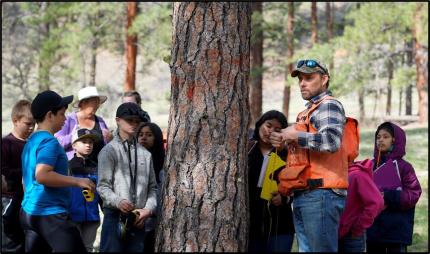
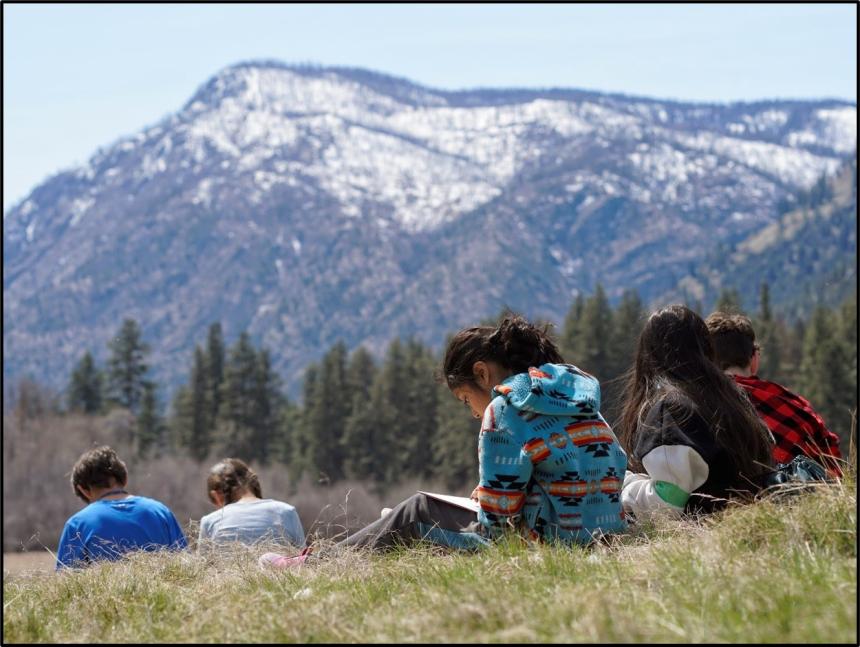
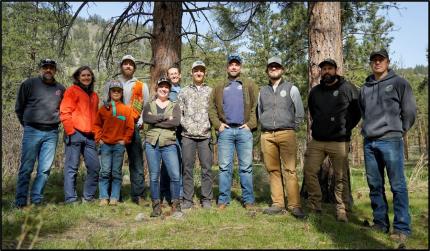
Conducting Business Operations and Policy
Agricultural Leases: Lands Operations Manager Haug met with Stewardship Section Manager Walls and Range Specialist Burnham to discuss a Methow Wildlife Area agricultural lease renewal as well as various other agricultural leases to begin the discussion on determining future rates to each lessee. More work to come this year on the subject.
Eder Tower: Haug, Scotch Creek Wildlife Area Dupont, and Region 2 Properties and Acquisitions Specialist Huynh met with a representative of the Okanogan County Sherriff’s office to discuss the possibility of deploying a communications tower on the Charles and Mary Eder Unit. Staff members asked for additional information and provided the official with an idea of what the request would take in terms of time and effort. The placement may be approximately two to three years out according to their representative and depends on whether or not their request is funded.
Sinlahekin Maintenance: Sinlahekin staff members continued to prepare equipment for the upcoming field season, Natural Resource Specialist White has been fabricating axles and a hydraulic lift for the harrow seeder that will be used to seed native grass seed on some shrubsteppe restoration sites on the Chiliwist Unit. Staff members will continue with other maintenance activities. They also started annual maintenance of the access site parking lots through the various units of the wildlife area. This treatment will help prevent noxious weeds from growing in the parking lots and help to minimize potential fire hazards.
Scotch Creek Maintenance: Staff members continued doing maintenance and repairs on vehicles, ATVs, small engines, and farm equipment. They also worked with a local vendor to locate and dig up the septic tank in the office yard. The vendor will be back next week to pump it.
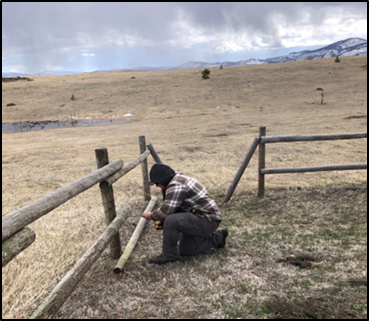
Virtual Tour: Haug presented a virtual tour of wildlife areas and water access areas in Okanogan County to the Lands Division at their quarterly meeting. The presentation talked generally about the wildlife and water access areas and touched on successes and challenges. Hopefully, the virtual tours will become a standard segment of each meeting.
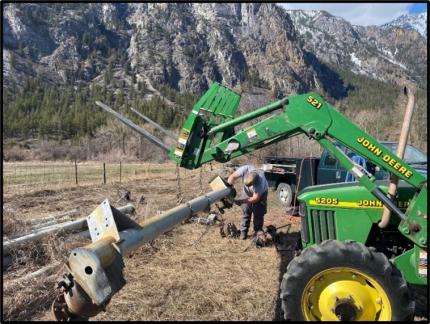
Hiring of Natural Resource Technician: Private Lands Technician Blanchard has been completing new employee hiring and orientation and began studying for his pesticide applicator license. Blanchard will increase the capacity for Region 2 Private Lands to install and improve wildlife habitat. Biologist Cook assisted Blanchard with orientation. They visited habitat sites throughout southern Grant and Adams counties. Blanchard will primarily be working on installation and maintenance of habitat improvements in Grant and Adams counties but will also work throughout WDFW Region 2.
State Acres for Wildlife Enhancement Conservation Reserve Program Cancellation: Private Lands Biologist Braaten worked with Olympia staff members on figuring out a solution to State Acres for Wildlife Enhancement (SAFE) workload. Natural Resources Conservation Service (NRCS) delivered news at a monthly meeting with WDFW staff members that they will be canceling our contribution agreement effective immediately. This left a lot of unanswered questions but provided some breathing room for NRCS who is restructuring workload to be ready for the IRA funds coming in October. This means a different approach in managing Department of Agriculture Farm Service Agency’s (FSA) Conservation Reserve Program (CRP). Private Lands Braaten spent several hours contacting landowners and local NRCS working out details. Private Lands staff will still work with and be available to landowners to assist where we can.
Equipment Delivery: Private Lands Biologist Braaten took delivery of new tractor with front loader this week.
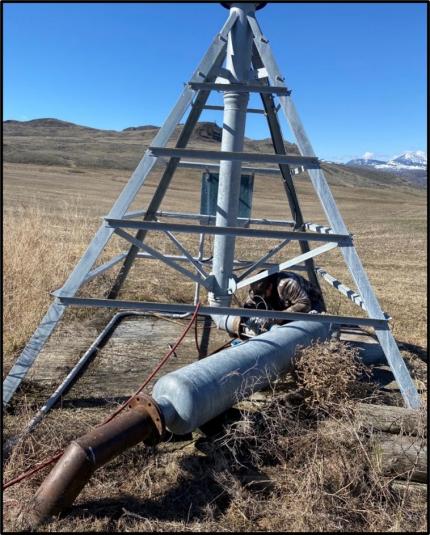
Scotch Creek Pivot Clean Up: In 2020, a windstorm blew over the south pivot on the Chopaka Unit. The severely damaged pivot was dismantled and stacked in the corner of the field, spring of 2020. This week staff members removed all the tires, gear box, center drives, drive lines and hauled them to the Eder Unit for storage and reuse. The remaining large pieces of metal and pipe will be picked up by the WDFW construction shop later this spring for recycling.
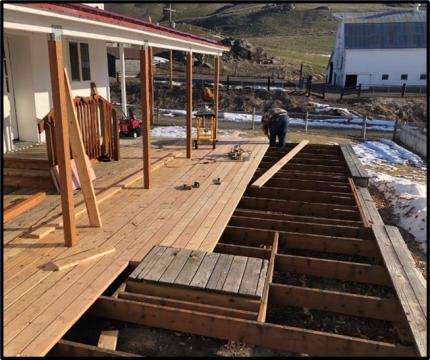
Scotch Creek Deck Repair: Scotch Creek staff members completed the replacement of all four-posts supporting the awning covering the back porch of the office. The old posts were starting to deteriorate and were compromising the integrity of the awning. Staff members also replaced the deck boards and cover to the domestic well.
Accessibility: Lands Operations Manager Finger participated in a meeting with Bureau of Reclamation staff members to discuss accessibility of sites for people with disabilities. Bureau of Reclamation conducted a field assessment which indicated that a number of sites are out of compliance. Finger is developing a transition plan which will establish goals and timelines for reaching compliance for water access sites location on federal lands and has begun discussions with WDFW Communication and Public Engagement (CAPE) which will hopefully lead to a standardized sign to inform users on where our accessible sites occur. This will likely be done using a QR code to link to our website accessibility page. We will update the website information with georeferenced maps and a description of all Americans with Disabilities Act/ Architectural Barriers Act opportunities.
County Commissioners: Finger accompanied Regional Director Hoenes in a meeting with Grant County Commissioners to discuss three potential acquisition projects and to provide an update on the future development of a target shooting range facility.
Wildfire Coordination Meeting: Finger chaired an annual meeting with local, state, and federal fire protection agencies to coordinate on local access, prescribed burn projects, fire protection contracts, and contact info, etc. in preparation of the upcoming fire season.
Livestock Billing: Biologist McPherson has been receiving livestock reports from grazing permit holders. Now that McPherson has received those billing letters, grazing permit statements and harvest reports can be sent out to permit holders for billing.
Oil and Fuel Recycling: Biologist McPherson coordinated with Safety-Kleen who recycles and picks up both oil and fuel from facilities. Our headquarters are scheduled for pick up on site for our oil, diesel, and gas.
Columbia Basin Wildlife Area Headquarters Yard Maintenance: Wildlife area staff members took an opportunity to do some gravel maintenance work on our laydown yard at headquarters. The newly acquired box scraper and a harrow pulled by truck did a great job of leveling and smoothing out gravel.
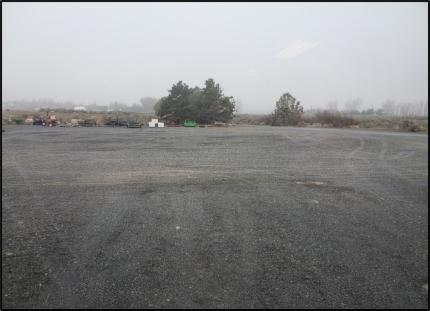
Other
New technician: District 7 biologists just welcomed a new biological technician onto their team for the 2023 summer season! Technician Hara will be assisting in greater sage-grouse and sharp-tailed grouse lek counts and lek surveys as well as upcoming Washington ground squirrel surveys.
Red Card Training: Specialist Walker completed the online portion of red card certification through the National Wildlife Coordinating Group. To finish the red card certification training, Specialist Walker will need to complete a day of live fire training and pack test.
Specialist Heilhecker listened to the Wolf Advisory Group meeting and completed mandatory online training for fall protection and hazardous chemicals.
Bobcat Sealed: Specialist Heilhecker sealed two bobcats taken in Game Management Unit 204.
Injured Raptor: Specialist Heilhecker spoke to a landowner regarding an injured raptor. The landowner had no interest in calling the nearest raptor rehabilitator in Kettle Falls. She informed the landowner to leave the raptor alone and let nature take its course.
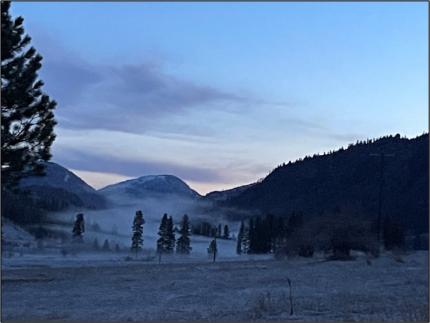
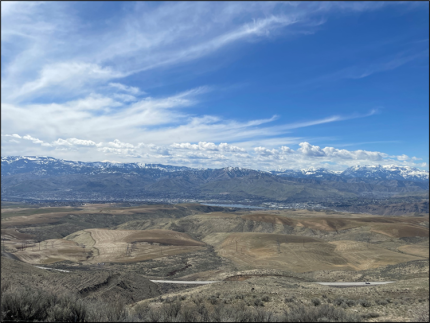
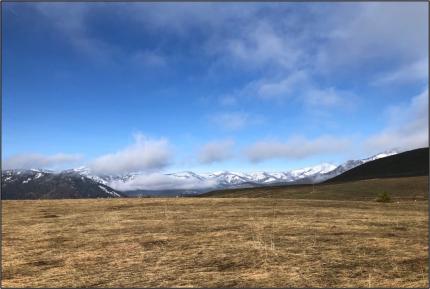
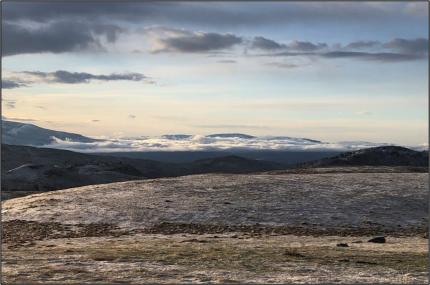
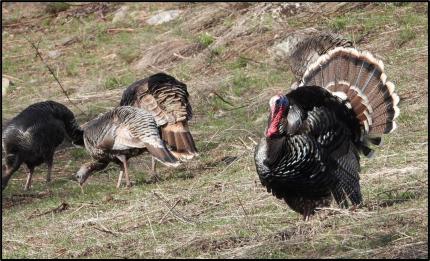
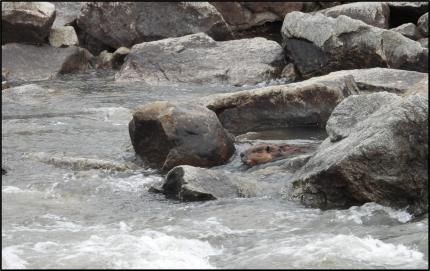
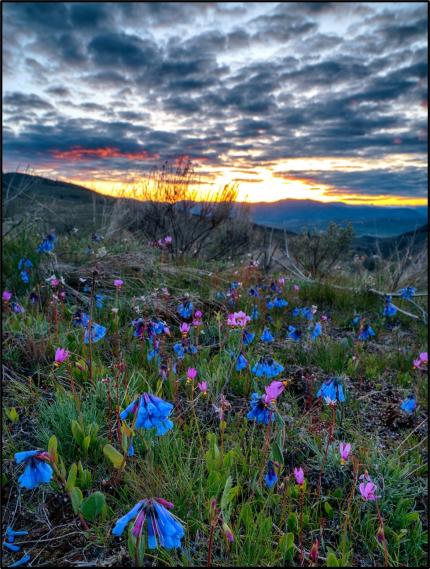
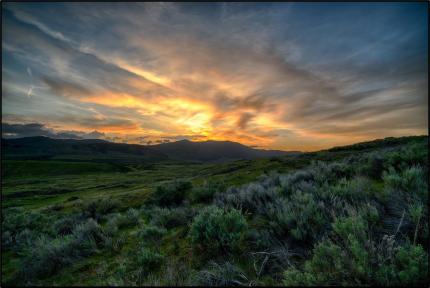
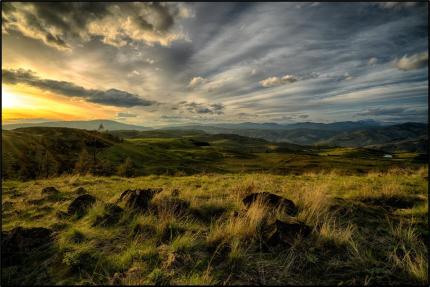
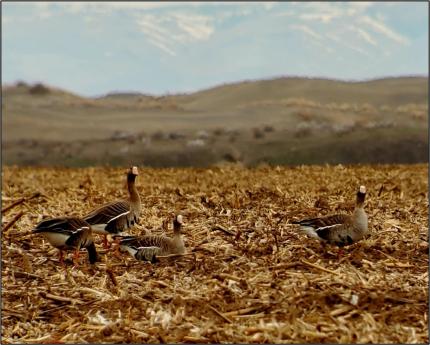
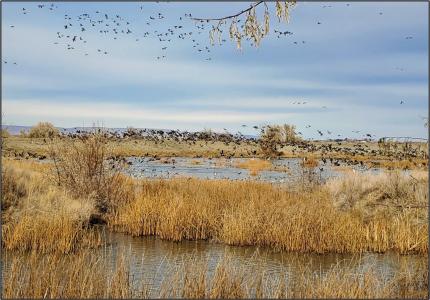
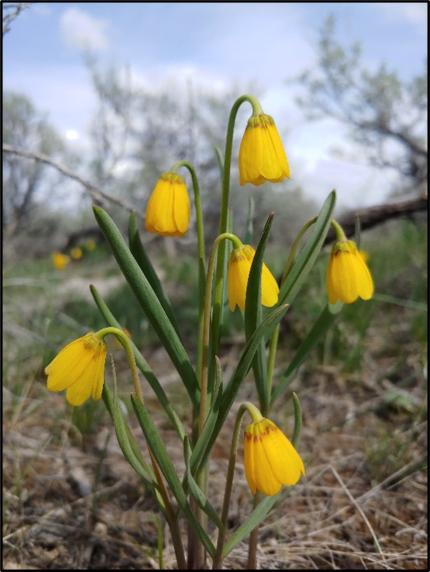
Managing Wildlife Populations
L. T. Murray Wildlife Area, Whiskey Dick Unit: Manager Morrison joined members of the Ecostudies Institute in the field while they were conducting horned lark (Eremophila alpestris) nest searching and monitoring, and bird captures in the Whiskey Dick and Quilomene areas. The search and captures are part of a pilot study to gather further information about lark introduction to new locations. The pilot study supports a greater study to facilitate work in supporting population of threatened listed streaked horned larks (Eremophila alpestris strigata).
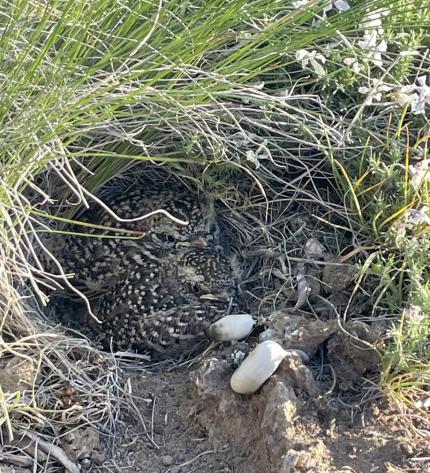
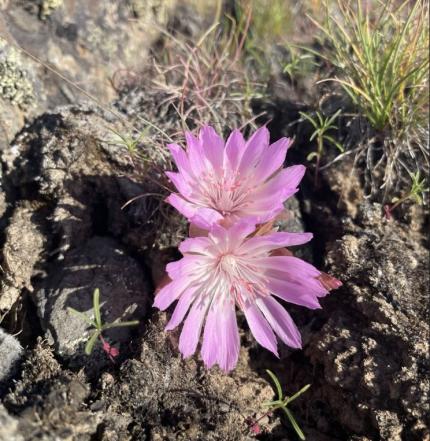
Sunnyside and Snake River: Manager Kaelber assisted volunteers from the Richland Rod and Gun Club with servicing wood duck nesting boxes in the Sunnyside Headquarters and Byron Units. Several boxes were being occupied with nesting wood ducks, as well as screech owls and kestrels.
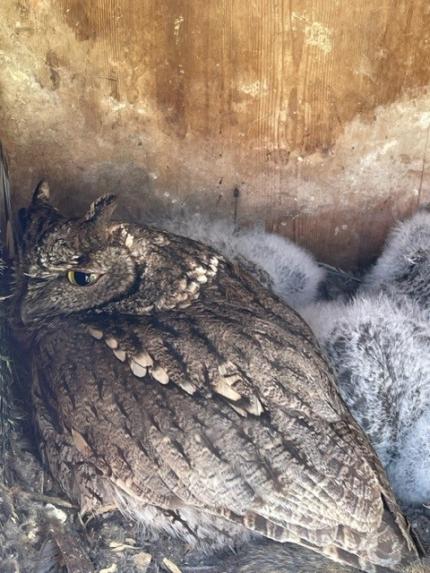
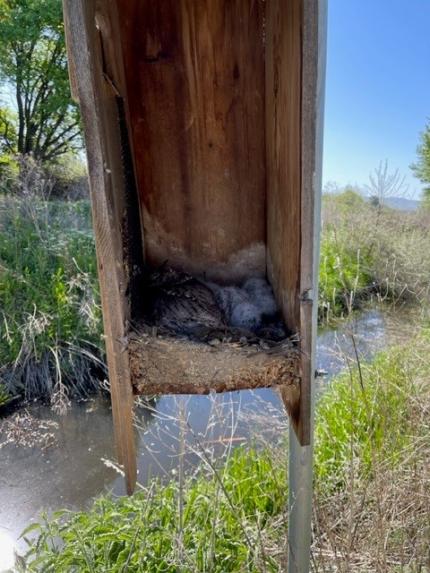
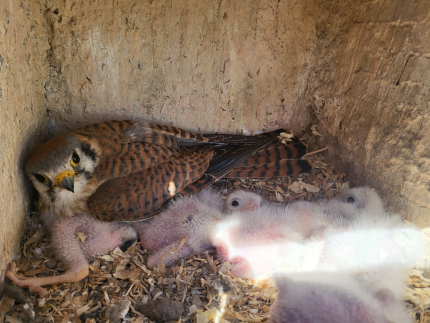
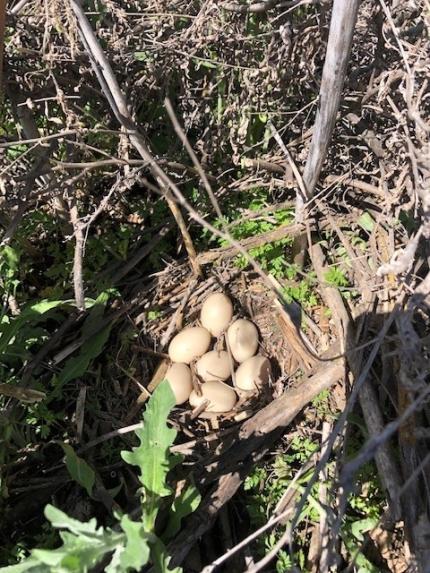
Bighorn Sheep Monitoring: Collared individuals from the ‘Test and Remove’ study sites continue to be monitored. District personnel responded to two mortalities occurring the past two weeks within the Cleman Mountain population due to vehicle strike and a likely predation event. Nasal swabs and heads were collected and sent for additional testing. Nasal swabs test for active infection, while heads are inspected for nasal tumors. The presence of tumors would indicate chronic Mycoplasma ovipneumoniea (M. Ovi).
Mule Deer Coordination: District biologists gathered with ungulate specialist personnel to discuss current and future mule deer monitoring and management.
Ground Squirrels: District 8 staff members continued to conduct surveys for Townsend ground squirrels on private and public lands. Ground squirrel colonies have seen drastic declines. Staff members have been revisiting historic colony sites and investigate new areas on private lands. District 8 personnel have registered several new colonies in the area hosting large family groups.
Providing Recreation Opportunities
End of Winter Closure: On May 1, Natural Resource Technician Stoltenow and Assistant Manager Taylor opened gates in the Wenas Wildlife Area allowing public access to the winter closure area. At the time of opening, there were around 26 vehicles at the Hardy Canyon gate and one vehicle at the gate at the top of Woodcamp Road looking to access the winter closure area for shed hunting.
Providing Conflict Prevention and Education
Rattlesnake Hills Elk: Wildlife Conflict Specialist Hand processed and issued damage prevention permits to several landowners in elk area 3721. These permits, for antlered bull elk only, are an extremely effective tool used for hazing elk away from valuable crops during the growing season.
Richland Deer: Wildlife Conflict Specialist Hand and Sergeant Fulton responded to an injured deer call in Richland. They observed a young buck mule deer that could not move its rear legs and appeared extremely emaciated. The deer was lethally removed, and the carcass was taken to a Department of Transportation disposal site.
Pasco Fox: Wildlife Conflict Specialist Hand responded to call from a Pasco homeowner who has lost chickens, ducks, and rabbits to a fox. The reporting party has witnessed the fox in the act of depredations in the past and assumed the recent attacks are from the same animal. Multiple protective measures were discussed as well as potential use of a Wildlife Control Operator for possible trapping.
Prosser Bald Eagle: Wildlife Conflict Specialist Hand responded to an injured wildlife call concerning a bald eagle hanging from a powerline in the Prosser area. Local power company staff were alerted to the situation and were available to assist, but unfortunately the adult eagle died prior to any rescue attempt. The bird was tagged and labeled for shipment to the National Repository.
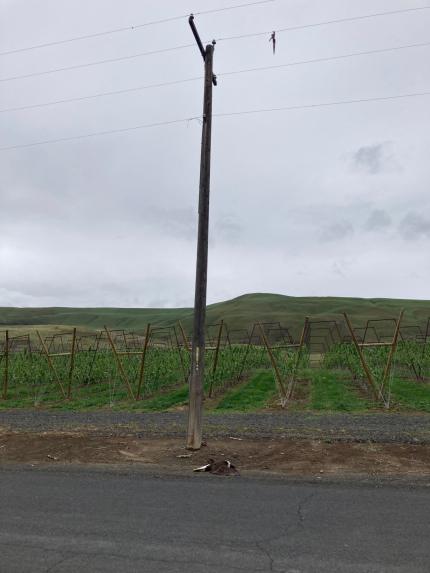
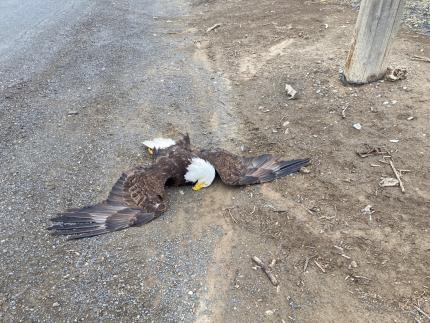
Kittitas County Conflict: Conflict Specialist Wetzel worked with several hay growers who were having problems with elk in crops. Elk have been hazed from irrigated hay, row crops, and at haystacks. Greenup is helping to keep elk higher and on public land.
Yakima County Conflict: Conflict Specialist Wetzel worked with several hay growers who were having problems with elk in crops. Elk have been hazed from irrigated hay, row crops, and orchard areas.
Wetzel Other: Conflict Specialist Wetzel assisted enforcement with trapping a cougar that killed a housecat. The cougar did not return to the trap.
A deer mortality was recovered in the Teanaway. A second also occurred in a very remote area that will be recovered when snow recedes.
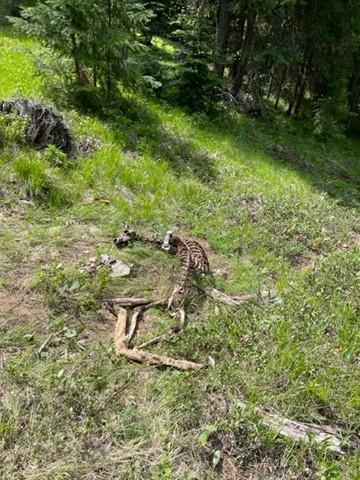
Wolf Activity: Individual wolves have been reported but not verified in any one location. No packs are present at this time.
Wenas Elk Fence Check: Natural Resource Worker Frame and Biologist Miller finished the spring elk fence checks. They ensured the fence was intact in places of the wildlife area bordering areas that will be holding livestock.
Wenas Breakaway Installation: Natural Resource Specialist Frame and Natural Resource Technician Stoltenow installed breakaway fencing in a drainage along Newlands Road, between two sections of elk fence installed last summer. The purpose of this fence is to breakaway in the event of a major flooding or debris flow event, so that the rest of the fencing is not damaged.
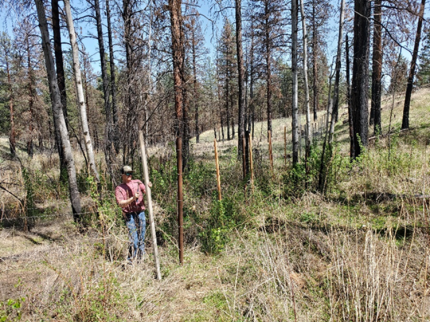
Conserving Natural Landscapes
Colockum Litter Cleanup: Manager Lopushinsky coordinated with WDFW Enforcement and the Wenatchee Sportsman’s Association in cleaning up a very nasty garbage site near Lily Lake in the Stemilt Basin. After being alerted to the problem the Sportsman’s Association responded immediately to rally volunteers and pick up and haul this garbage pile to the local landfill.
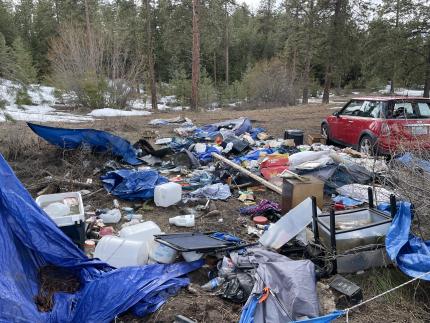
Mowing at Mattoon and Fio Rito: Access Manager Garcia mowed Mattoon and Fio Rito to reduce non-native fire risk and to improve weed management.
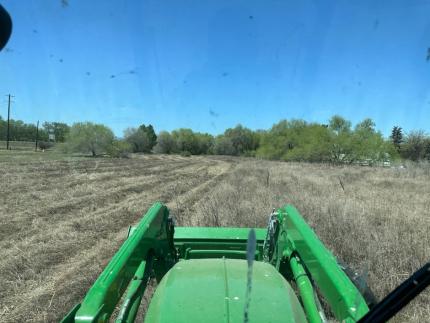
Boundary Fence Repair: Access Natural Resource Technician Barbosa and Natural Resource Worker Wolff repaired fences at Pond1, Pond 2, and Pond 3.
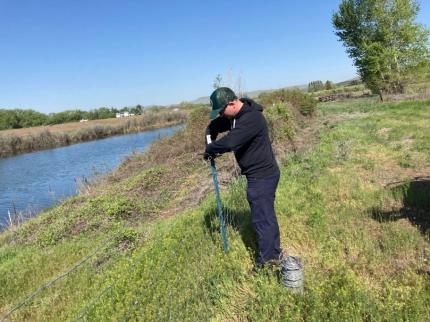
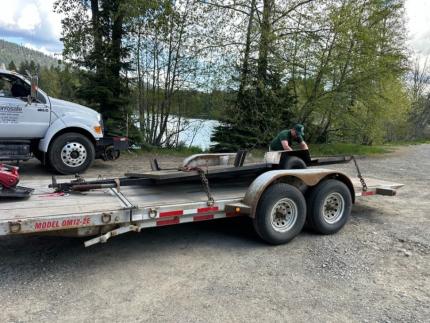
Graffiti: Access Natural Resource Tech Barbosa and Natural Resource Worker Wolff painted out graffiti at Pond 6.
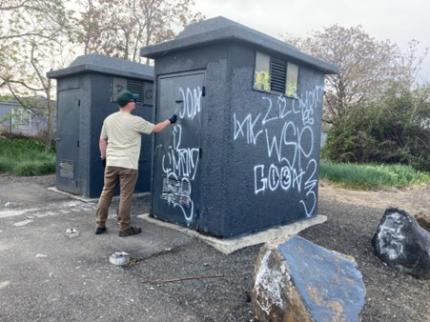
L. T. Murray Wildlife Area, Quilomene Unit Grazing: Assistant Manager Winegeart and Natural Resource Workers Schneider and Hamlin completed pre-grazing vegetation utilization monitoring on the Quilomene Unit’s Whiskey Jim pasture. The pasture showed very little to no grazing from wildlife.
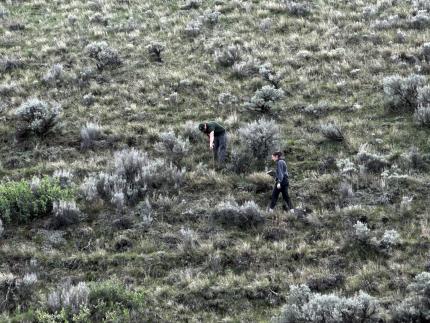
Beacon Ridge Road Gate: Natural Resource Technician Blore built a gate across the Quilomene Unit’s Beacon Ridge Road to be used while cows are in the Upper Parke pasture during the first half of July.
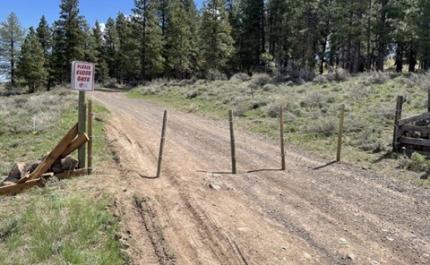
Sunnyside and Snake River: Manager Kaelber, Assistant Manager Jahns, and Natural Resource Technician Manderbach visited the Thornton Unit to evaluate a wildlife food plot that was recently seeded. There was new growth of the seeded species, as well as regrowth of grasses.
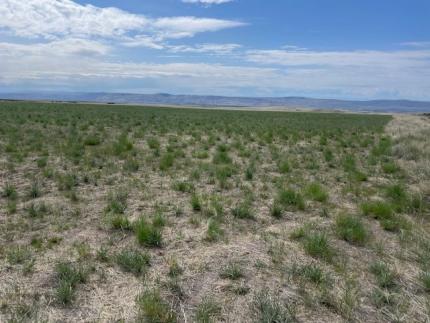
Colockum Wildlife Area, Post Burn Activities: WDFW staff members conducted a 270-acre prescribed burn on the Colockum Wildlife Area last fall. This spring things are greening up nicely, and this month staff are seeding the containment lines with native grasses.
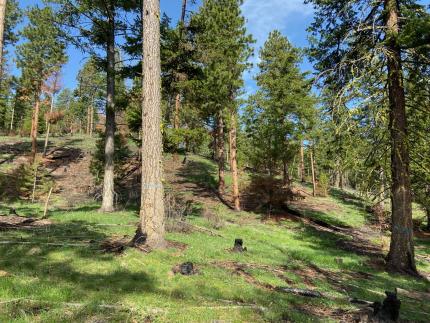
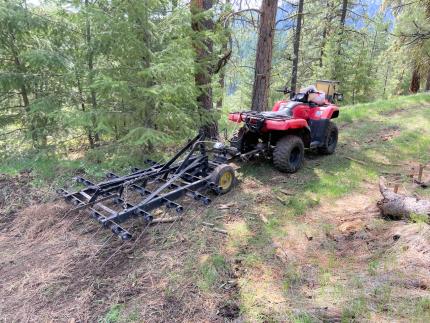
Other
L. T. Murray Wildlife Area, Quilomene Unit: Assistant Manager Winegeart presented information to the Region 3 management team regarding a new private firing range being developed a few miles east of Ellensburg on the Vantage Highway. The property sites between the Green Gate subunit or the L. T. Murray Wildlife Area, Quilomene Unit and the Wild Horse wind farm and was almost purchased by DFW for a public firing range around five years ago. The range is owned by Vantage Valley Properties LLC and is currently being used by local law enforcement for target practice.
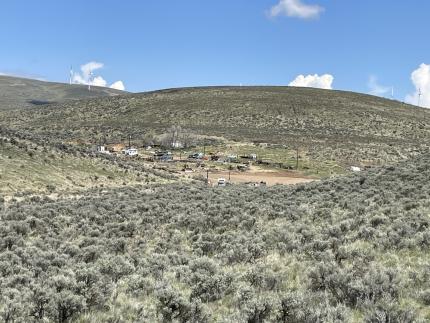
Sunnyside and Snake River: Assistant Manager Jahns and Natural Resource Technician Manderbach continue to implement integrated pest management strategies to control noxious weeds throughout the wildlife area.
Providing Recreation Opportunities
Snoqualmie Wildlife Area Truck Bay Construction: Wildlife Area Manager Boehm reported that the rebuilding of the truck bay for the Cherry Valley pheasant pen facility has been completed. The non-closing doors, sagging, miss-matched lumber, rotting posts, and countless “band-aid” fixes of the original truck bay required a complete rebuild. Boehm was contacted by Master Hunters Darin and Jon, a father-son team, that needed a project. After discussing timeframe, skills, and project requirements, the project was placed in their hands.
After producing a detailed design, the construction team demolished the old structure except for some original good posts. They completed the foundation, framing, wire wrap, groundwork, and door alignments over three weekends in April. After over 80 combined hours, they produced a new truck bay standing on the original footprint. This project reinforces the great work the Master Hunter volunteers provide, while supporting the goals of the Department of Fish and Wildlife. We hope this truck bay will last for many decades to come.
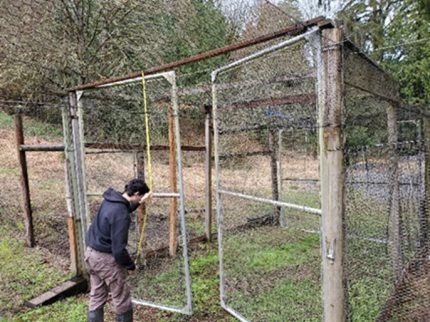
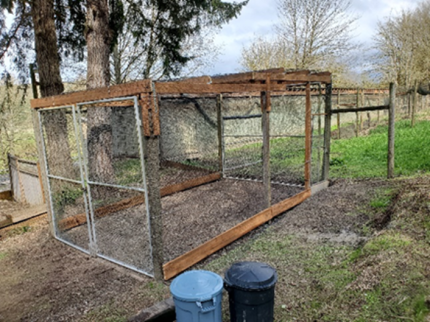
Managing Wildlife Populations
Banding Pigeons: In a game of Hurry Up and Wait, Wildlife Area Manager Hauswald and Assistant Manager Risley banded eight band-tailed pigeons near Woodland, Washington. The Pacific Coast band-tailed pigeon is managed as a migratory game bird in Washington. Its population is low for several reasons, but habitat loss is a significant contributing factor. Relocation of these banded pigeons may help Washington Department of Fish and Wildlife (WDFW) biologists identify important locations that can be added to a growing list of sites for monitoring along coastal and interior portions of Washington. Relocation data can also be used to learn more about migration timing, as well as winter use areas.
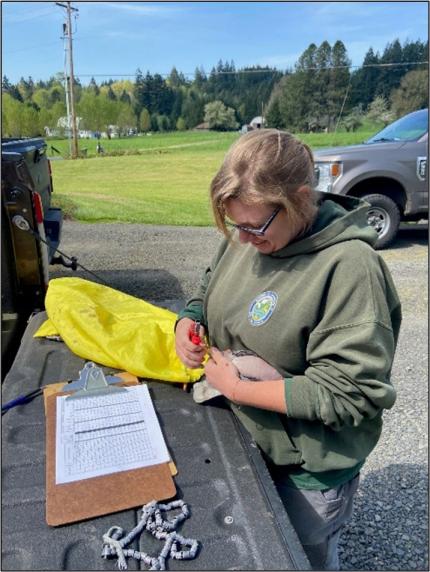
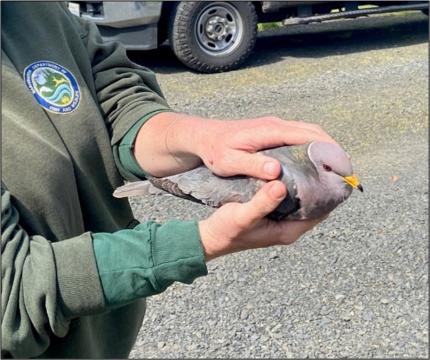
Annual Mule Deer Meeting: Biologists Bergh and Wickhem attended the annual meeting for WDFW staff members who manage mule deer. The group discussed survey methodology and potential improvements, data management and improvements, disease, migration research, and habitat work.
Providing Conflict Prevention and Education
Black Bear Damage: Wildlife Conflict Specialist Jacobsen received multiple reports of a black bear breaking into sheds and chicken coops in a western Skamania County neighborhood. The bear recently consumed eight chickens in one coop. Jacobsen and Conflict Technician Kolenberg conducted a site visit to examine the damage and to determine what actions were necessary. Based on the nature of the incidents and time of year, Jacobsen decided to set a trap for the bear. Jacobsen and Kolenberg provided advice on securing attractants and electrifying chicken coops to the landowner. Trail camera surveillance and an empty trap indicated that the bear had not been back to the area over the following week, and the trap was pulled from the residence. Jacobsen received a report the next week of the bear raiding garbage cans, on garbage collection day, roughly one mile away. Jacobsen and Kolenberg will continue to monitor the situation and respond to any additional reports that come in from this area.
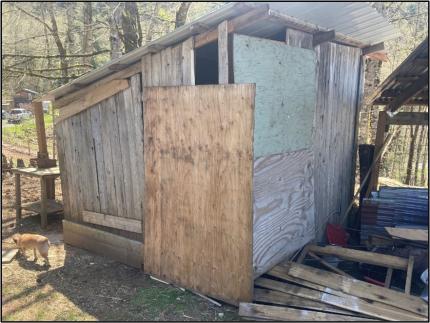
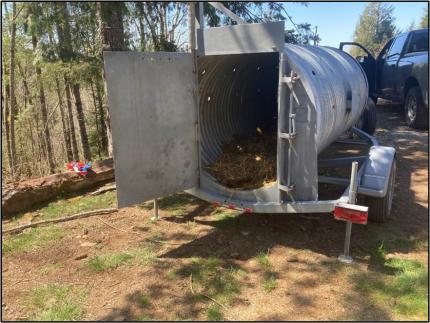
Raccoon Assistance: Wildlife Conflict Specialist Jacobsen responded to a nearby residence in Klickitat County where a raccoon was caught in a live animal trap. The homeowner was attempting to catch feral cats but accidentally caught a raccoon instead. The elderly homeowner was not familiar with handling wildlife and, due to her concern of being bitten, requested WDFW’s assistance to release the raccoon. Jacobsen arrived at the residence and demonstrated to the homeowner how to release the raccoon from the trap so that she could do it herself in the future should the situation arise again. The homeowner, as well as the distraught raccoon, was very appreciative of the assistance.
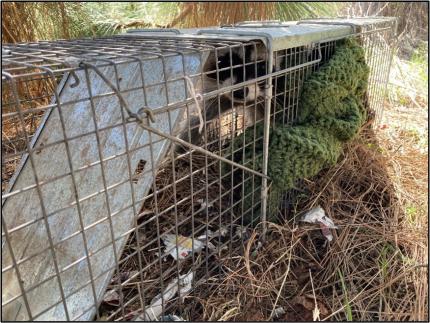
Bear Complaint: Wildlife Conflict Specialist Jacobsen provided advice over the phone to a landowner who was watching a black bear in her yard from her house window. The landowner was concerned about the bear presence in the area. The landowner was able to successfully scare the bear away with a siren sound on her phone. After discussing the incident with the landowner, Jacobsen found out that the bear had previously discovered bird feeders at the residence and had helped itself to the bounty. The landowner had since secured her attractants, but the bear apparently came back to see if bird food was on the menu that day.
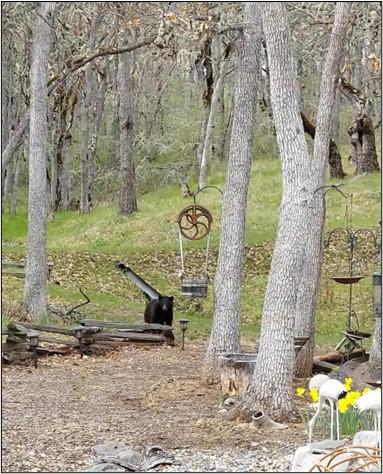
Injured Bobcat: A motorist was driving through Klickitat County when she observed an injured bobcat along the side of the road near a popular hiking trail. She contacted Wildlife Conflict Specialist Jacobsen, who happened to be 15 minutes away at the time of the report. Jacobsen responded to the scene. Despite the fact that the bobcat didn’t even try to move when the motorist photographed it a short while earlier, it was no longer at the scene when Jacobsen arrived. Jacobsen searched on foot but was unsuccessful. Given the proximity to the popular hiking trail, which is advertised as a dog-friendly trail and is heavily used by two and four-legged recreationists, Jacobsen requested a local houndsman assist in locating the bobcat in the hopes that it could be immobilized, captured, and transferred to a rehabilitation clinic. Unfortunately, or fortunately, the houndsman was not able to locate the bobcat either, which likely means the bobcat was still fairly mobile and likely to recover from its injuries.
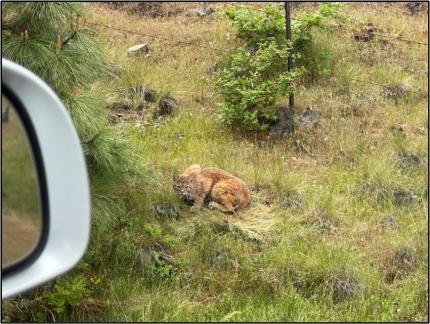
Injured Bald Eagle: Wildlife Conflict Specialist Jacobsen received a phone call from a concerned citizen who had found an injured bald eagle. The eagle was in a grassy field at Beacon Rock State Park. Jacobsen responded to the location with Ranger Yeats and the reporting party. Jacobsen was able to successfully capture the eagle and transfer it to the Rowena Wildlife Clinic where its condition was assessed. The eagle turned out to be slightly emaciated and had an injury under one of its wings. It is now receiving treatment and is recovering at the rehabilitation clinic in Oregon.
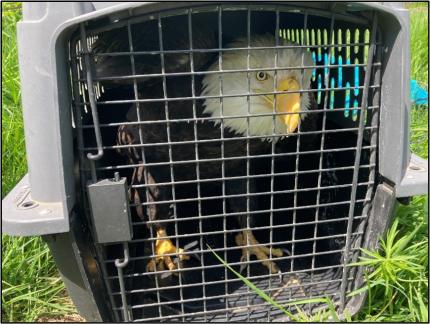
Capture and Release of Elk with Portions of a Hammock Entangled in His Antlers: Biologists Stephens and Holman teamed up to capture an elk with portions of a hammock entangled in his antlers. The subject elk spends most of his time within the city limits of Packwood and first became entangled with the hammock in October 2022. At that time, Conflict Specialist Aubrey evaluated the elk and discussed its situation with district wildlife biologists. Consensus at that time was that since the animal could eat, move, and drink and because it was post-rut, the elk would both survive and be unlikely to become entangled with another bull. Furthermore, the situation would likely resolve itself without WDFW intervention when the bull shed his antlers during the following spring.
The elk subsequently survived several months. During that time, the elk generated a lot of interest among the citizens of eastern Lewis County. Media coverage including Tacoma and Centralia newspapers as well as Seattle’s King 5 News all ran stories on the elk. Thanks to Conflict Specialist Aubrey for fielding the many public contacts regarding this animal.
On approximately April 23, the bull shed his antlers but failed to free himself from the entangling material. District 10 staff members discussed the situation again and decided that a capture attempt was warranted. On May 2, Biologists Stephens and Holman successfully captured the elk, removed the entangled material, treated the underlying tissue for infection, and released the elk on site.
WDFW posted the story on Facebook.
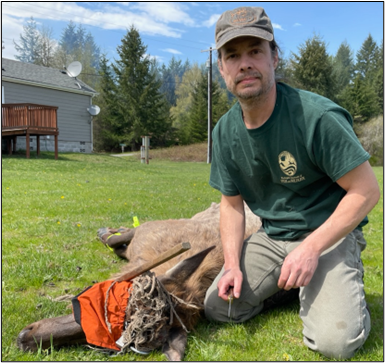
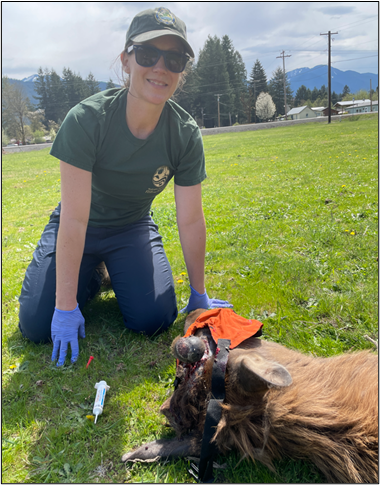
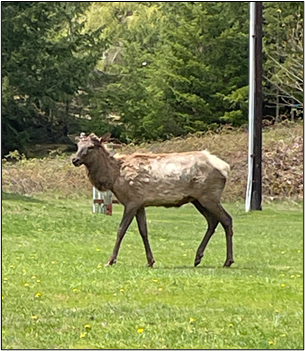
Conserving Natural Landscapes
Planting Peas for Wildlife: Wildlife Area Manager Hauswald and Assistant Manager Risley planted an estimated eight acres of peas at the Shillapoo Wildlife Area. Peas are popular with migrating waterfowl in the fall and winter months, specifically Canada and snow geese. Once the peas have grown, matured, and dried, the peas are then “shattered” making them an attractive and accessible snack for the migrators.
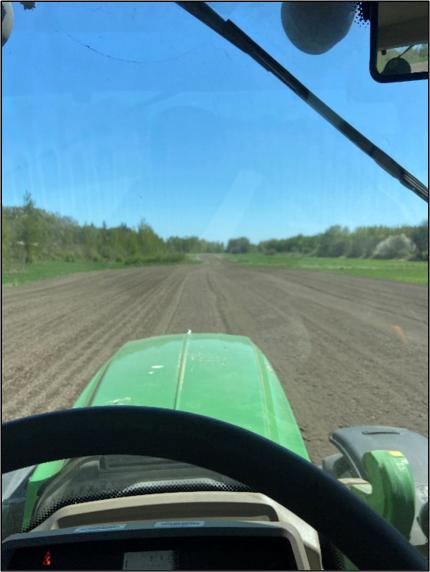
Removing Garbage from Access Program Land in Klickitat County: Private Lands Biologist Gray visited one of the WDFW Private Lands Access Program sites popular during the wild turkey hunting season to engage with hunters and get feedback on the program. While there, Gray stopped to drag large pieces of metal trash off the property and hauled them to the dump station to keep the property maintained.
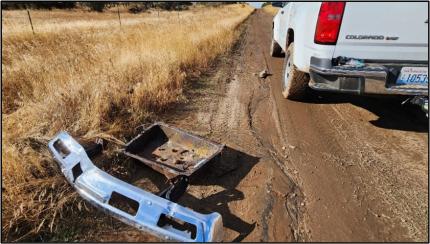
Providing Education and Outreach
Program Presentation in Cowlitz County: Private Lands Biologist Gray attended the combined annual meeting of the Cowlitz Farm and Forestry Association and the Cowlitz Conservation District as a speaker at the event. She gave a presentation about the WDFW Private Lands Access Program to an audience of 50 farmland and small forest landowners regarding how the program could help fit the goals of their land.

Bear and Cougar Mailers: Every year, Wildlife Conflict Specialist Jacobsen maps bear and cougar complaints throughout District 9 to help determine priority areas for education and outreach efforts. Last year, the White Salmon area was a source of abundant bear complaints. This spring, Jacobsen sent out a targeted bear/cougar mailer to the region. Thanks to tremendous help of the Region 5 Customer Service team and Conflict Technician Kolenberg in preparing the mailers. The mailer effort was able to reach over 3,400 residents of the greater White Salmon area. Hopefully these efforts will lead to reduced bear and cougar conflicts in the future!
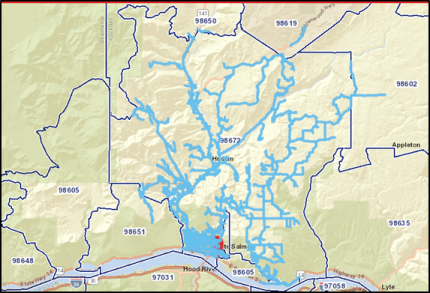
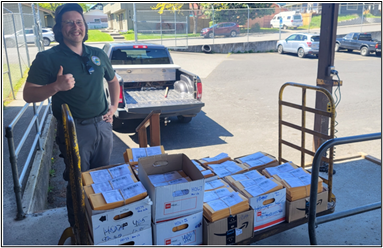
Wild About Nature 10 Series: Wildlife Conflict Specialist Jacobsen and Conflict Technician Kolenberg delivered presentations at the 10th annual Wild About Nature speaker series in White Salmon. Conflict Technician Kolenberg’s presentation focused on historic wildlife and landscape accounts of the Columbia River Gorge area pre-European settlement. Jacobsen’s presentation focused on observing wildlife with trail cameras. Roughly 55 members of the public were in attendance and the presentations were well received.
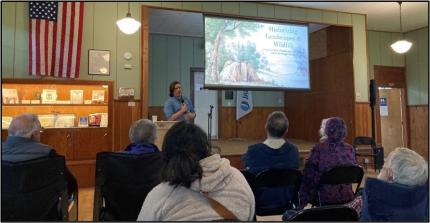
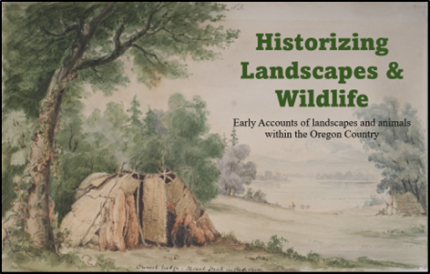
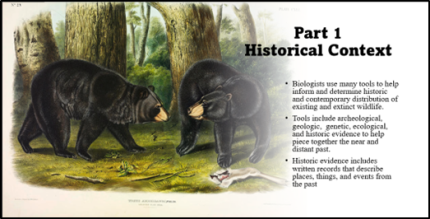
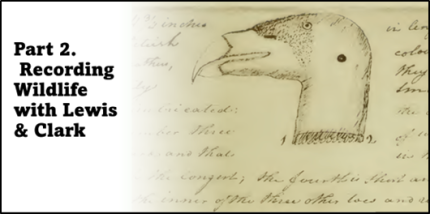
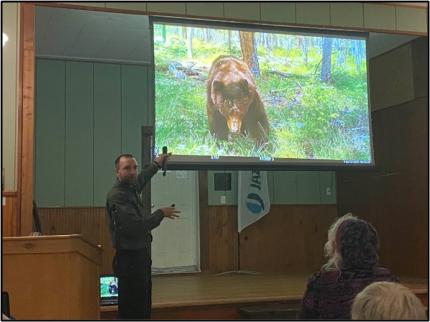
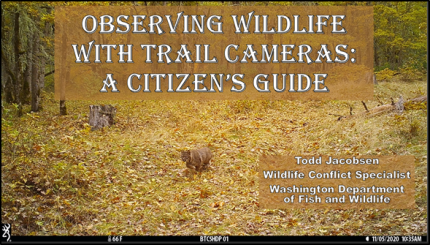
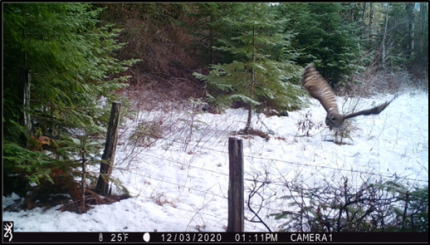
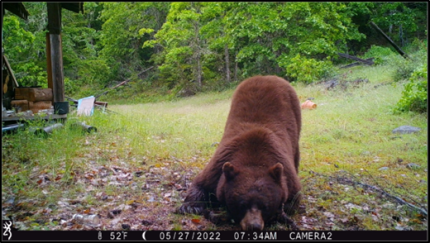
Conducting Business Operations and Policy
Immobilization Certification Course: Several Wildlife Program staff members from Region 5 attended WDFW Wildlife Immobilization and Capture courses held in Olympia and Ellensburg this week. This course is required for wildlife staff members every five years.